Space Tourism: Can A Civilian Go To Space?

2021 has been a busy year for private space tourism: overall, more than 15 civilians took a trip to space during this year. In this article, you will learn more about the space tourism industry, its history, and the companies that are most likely to make you a space tourist.

What is space tourism?
Brief history of space tourism, space tourism companies, orbital and suborbital space flights, how much does it cost for a person to go to space, is space tourism worth it, can i become a space tourist, why is space tourism bad for the environment.
Space tourism is human space travel for recreational or leisure purposes . It’s divided into different types, including orbital, suborbital, and lunar space tourism.
However, there are broader definitions for space tourism. According to the Space Tourism Guide , space tourism is a commercial activity related to space that includes going to space as a tourist, watching a rocket launch, going stargazing, or traveling to a space-focused destination.
The first space tourist was Dennis Tito, an American multimillionaire, who spent nearly eight days onboard the International Space Station in April 2001. This trip cost him $20 million and made Tito the first private citizen who purchased his space ticket. Over the next eight years, six more private citizens followed Tito to the International Space Station to become space tourists.
As space tourism became a real thing, dozens of companies entered this industry hoping to capitalize on renewed public interest in space, including Blue Origin in 2000 and Virgin Galactic in 2004. In the 2000s, space tourists were limited to launches aboard Russian Soyuz aircraft and only could go to the ISS. However, everything changed when the other players started to grow up on the market. There are now a variety of destinations and companies for travels to space.
There are now six major space companies that are arranging or planning to arrange touristic flights to space:
- Virgin Galactic;
- Blue Origin;
- Axiom Space;
- Space Perspective.
While the first two are focused on suborbital flights, Axiom and Boeing are working on orbital missions. SpaceX, in its turn, is prioritizing lunar tourism in the future. For now, Elon Musk’s company has allowed its Crew Dragon spacecraft to be chartered for orbital flights, as it happened with the Inspiration4 3-day mission . Space Perspective is developing a different balloon-based system to carry customers to the stratosphere and is planning to start its commercial flights in 2024.
Orbital and suborbital flights are very different. Taking an orbital flight means staying in orbit; in other words, going around the planet continually at a very high speed to not fall back to the Earth. Such a trip takes several days, even a week or more. A suborbital flight in its turn is more like a space hop — you blast off, make a huge arc, and eventually fall back to the Earth, never making it into orbit. A flight duration, in this case, ranges from 2 to 3 hours.
Here is an example: a spaceflight takes you to an altitude of 100 km above the Earth. To enter into orbit — make an orbital flight — you would have to gain a speed of about 28,000 km per hour (17,400 mph) or more. But to reach the given altitude and fall back to the Earth — make a suborbital flight — you would have to fly at only 6,000 km per hour (3,700 mph). This flight takes less energy, less fuel; therefore, it is less expensive.
- Virgin Galactic: $250,000 for a 2-hour suborbital flight at an altitude of 80 km;
- Blue Origin: approximately $300,000 for 12 minutes suborbital flight at an altitude of 100 km;
- Axiom Space: $55 million for a 10-day orbital flight;
- Space Perspective: $125,000 for a 6-hour flight to the edge of space (32 km above the Earth).
The price depends, but remember that suborbital space flights are always cheaper.
What exactly do you expect from a journey to space? Besides the awesome impressions, here is what you can experience during such a trip:
- Weightlessness . Keep in mind that during a suborbital flight you’ll get only a couple of minutes in weightlessness, but it will be truly fascinating .
- Space sickness . The symptoms include cold sweating, malaise, loss of appetite, nausea, fatigue, and vomiting. Even experienced astronauts are not immune from it!
- G-force . 1G is the acceleration we feel due to the force of gravity; a usual g-force astronauts experience during a rocket launch is around 3gs. To understand how a g-force influences people , watch this video.
For now, the most significant barrier for space tourism is price. But air travel was also once expensive; a one-way ticket cost more than half the price of a new car . Most likely, the price for space travel will reduce overtime as well. For now, you need to be either quite wealthy or win in a competition, as did Sian Proctor, a member of Inspiration4 mission . But before spending thousands of dollars on space travel, here is one more fact you might want to consider.
Rocket launches are harmful to the environment in general. During the burning of rocket fuels, rocket engines release harmful gases and soot particles (also known as black carbon) into the upper atmosphere, resulting in ozone depletion. Think about this: in 2018 black-carbon-producing rockets emitted about the same amount of black carbon as the global aviation industry emits annually.
However, not all space companies use black carbon for fuel. Blue Origin’s New Shepard rocket has a liquid hydrogen-fuelled engine: hydrogen doesn’t emit carbon but simply turns into water vapor when burning.
The main reason why space tourism could be harmful to the environment is its potential popularity. With the rising amount of rocket launches the carbon footprint will only increase — Virgin Galactic alone aims to launch 400 of these flights annually. Meanwhile, the soot released by 1,000 space tourism flights could warm Antarctica by nearly 1°C !
Would you want to become a space tourist? Let us know your opinion on social media and share the article with your friends, if you enjoyed it! Also, the Best Mobile App Awards 2021 is going on right now, and we would very much appreciate it if you would vote for our Sky Tonight app . Simply tap "Vote for this app" in the upper part of the screen. No registration is required!
New Shepard is ushering in a new generation of astronauts.
Soar Above the Kármán Line
Return to Earth, Forever Changed
New Shepard astronauts ascend toward space at more than three times the speed of sound. They pass the Kármán line, the internationally recognized boundary of space 62 miles (100 km) above Earth, before unbuckling to float weightless and gaze at our planet. The crew returns gently under parachutes, forever changed.
Inside the Capsule
Every Seat is a Window Seat
Gaze upon Earth from giant windows comprising one-third of the capsule’s surface area. The spacious and pressurized capsule seats six and is climate-controlled for comfort.
Learn, Train, Fly
Time to Train
Our on-site astronaut training program is meticulously designed to teach everything you’ll need to know for a safe spaceflight. Over two days, you’ll learn about New Shepard’s mission profile, safety systems, zero-g protocols, and execute mission simulations.
Welcome to West Texas
The Pioneering Spirit of Launch Site One
Spectacular sunrises, sunsets, and stargazing abound at Launch Site One, nestled in the Guadalupe Mountains near Van Horn, TX. You and your crew will stay at Astronaut Village, cultivating fellowship and memories to last a lifetime.
For the Benefit of Earth
Fully Reusable and Carbon-Free
Nearly 99% of New Shepard’s dry mass is reused, including its capsule, booster, and engine. During flight, the only byproduct of New Shepard’s engine combustion is water vapor with no carbon emissions.
Safety at the Center
Safety, Our Highest Priority
New Shepard began flying humans in 2021 following the conclusion of a rigorous flight test program. The crew capsule has numerous redundant safety systems. Its crew escape system has been successfully tested three times, demonstrating that it can activate safely during any phase of flight.
Join a new generation of astronauts.
© 2024 Blue Origin LLC
The future of space travel is here
An unforgettable experience , a spaceship like no other .
Introducing Spaceship Neptune—the safest, most accessible, and first carbon-neutral human spaceflight experience. Redefining the category of space travel, ours is the largest spaceflight capsule in existence.

The world's first Space Lounge
Explorers enjoy Wi-Fi, a world-class culinary program, plush safety seating, luxury amenities, and panoramic views through the largest windows ever flown to space—even a proper restroom (the Space Spa).
An unparalleled crew
Our world record-holding team have been instrumental in the development of every US human spacecraft for the past 40 years, including every human space balloon flight.
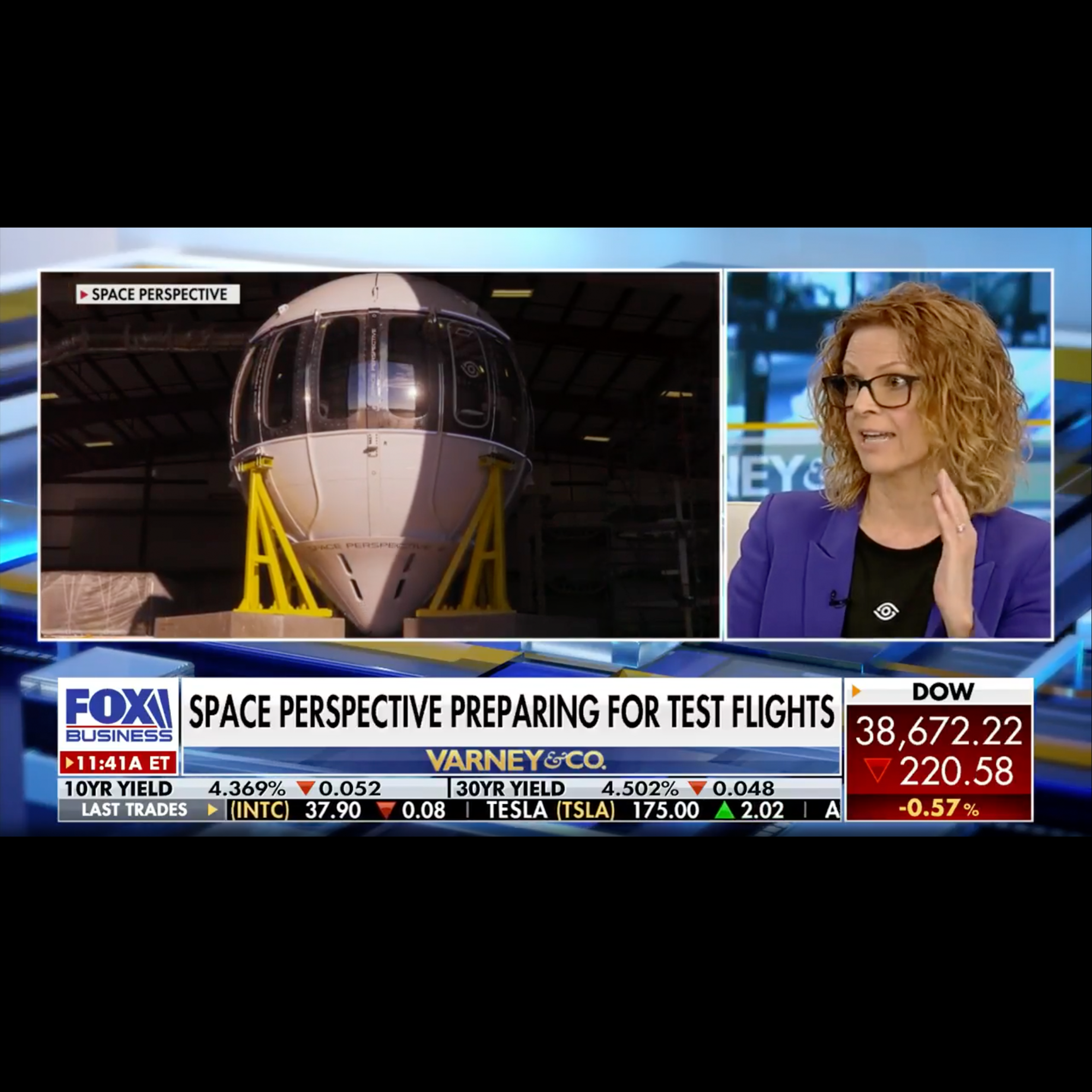
Fox Business's Varney & Co. Calls Space Tourism "Untapped Market"
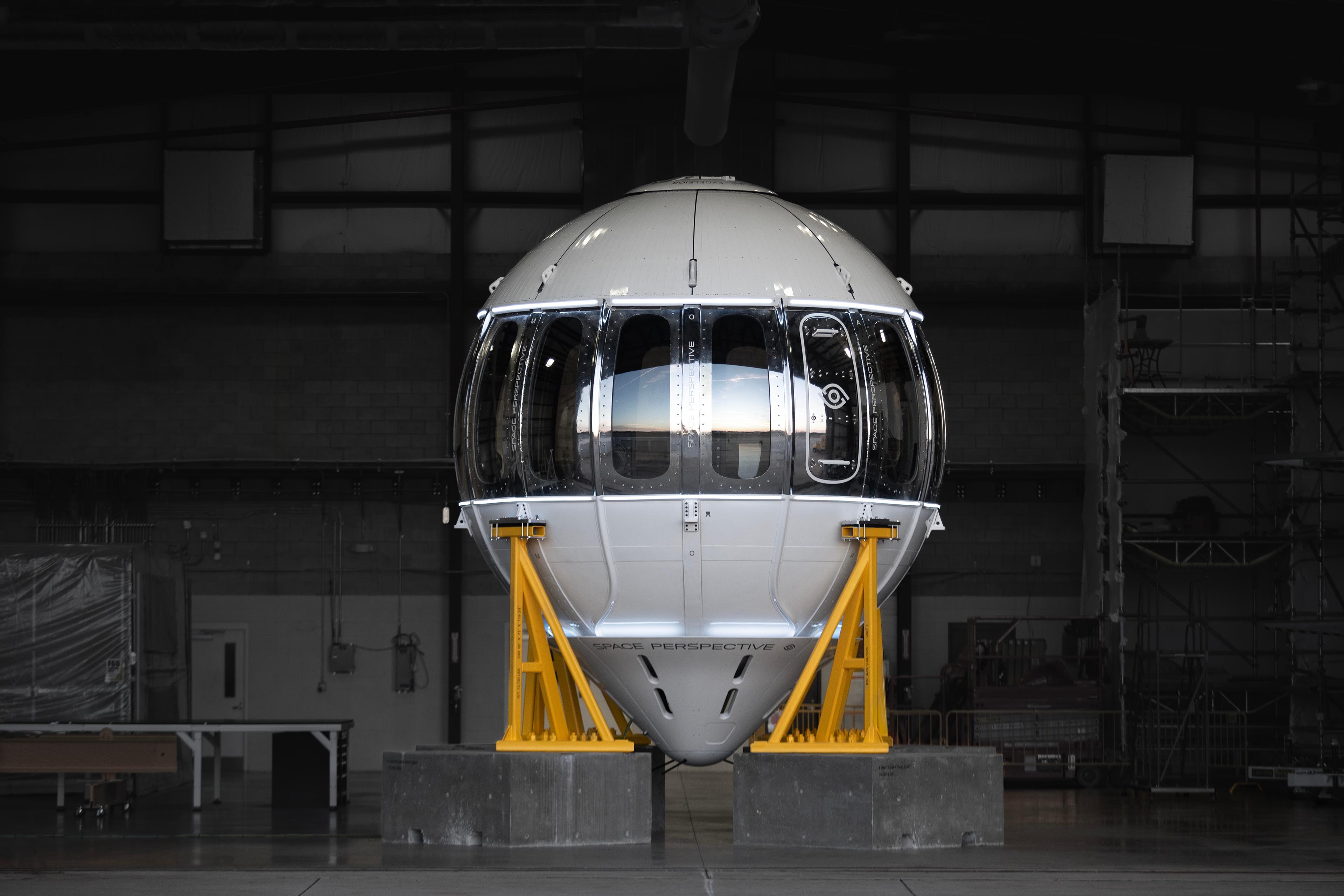
designboom Unveils First Images of Spaceship Test Capsule, Excelsior
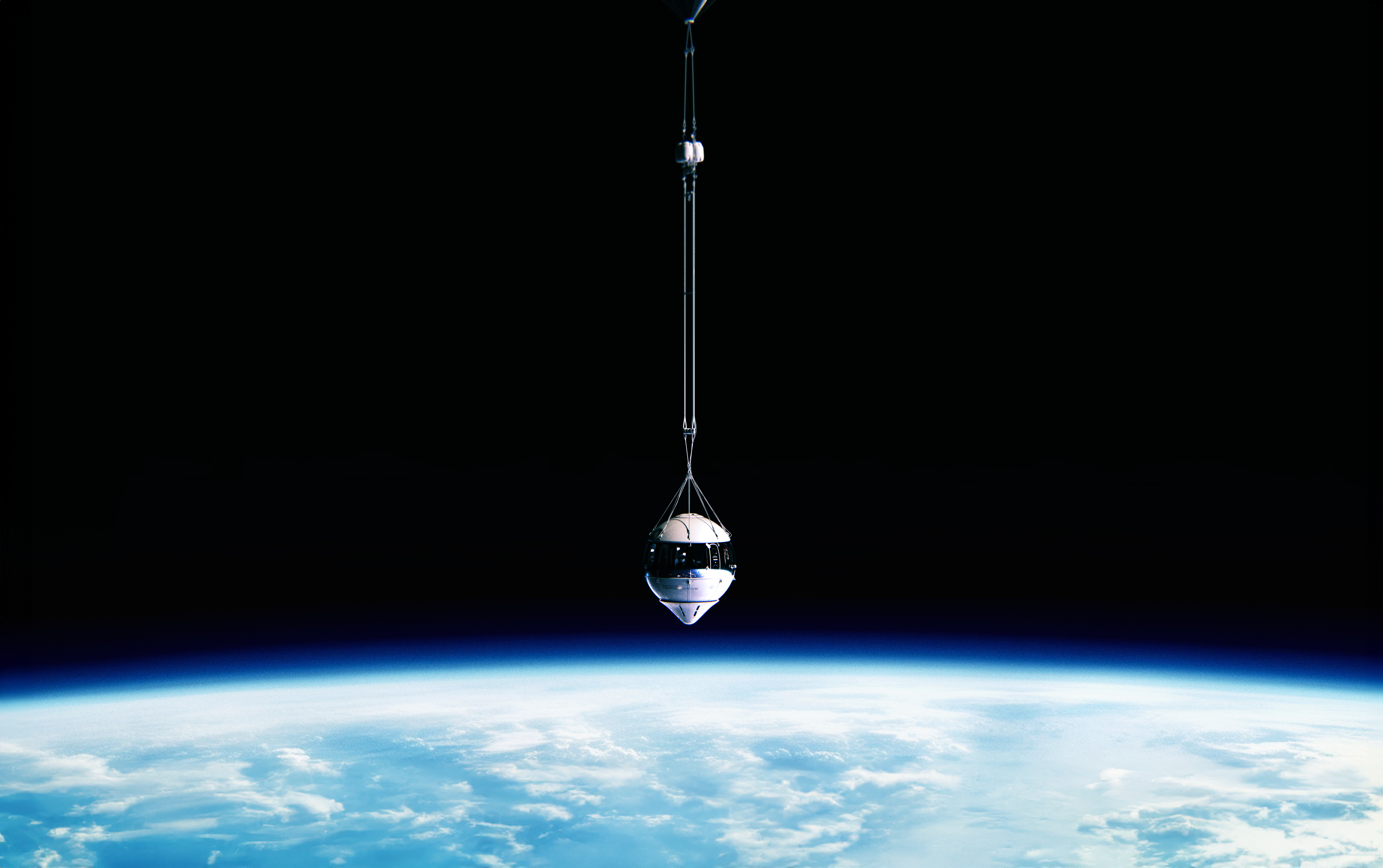
Barron’s Highlights Approach to Sustainable Operations
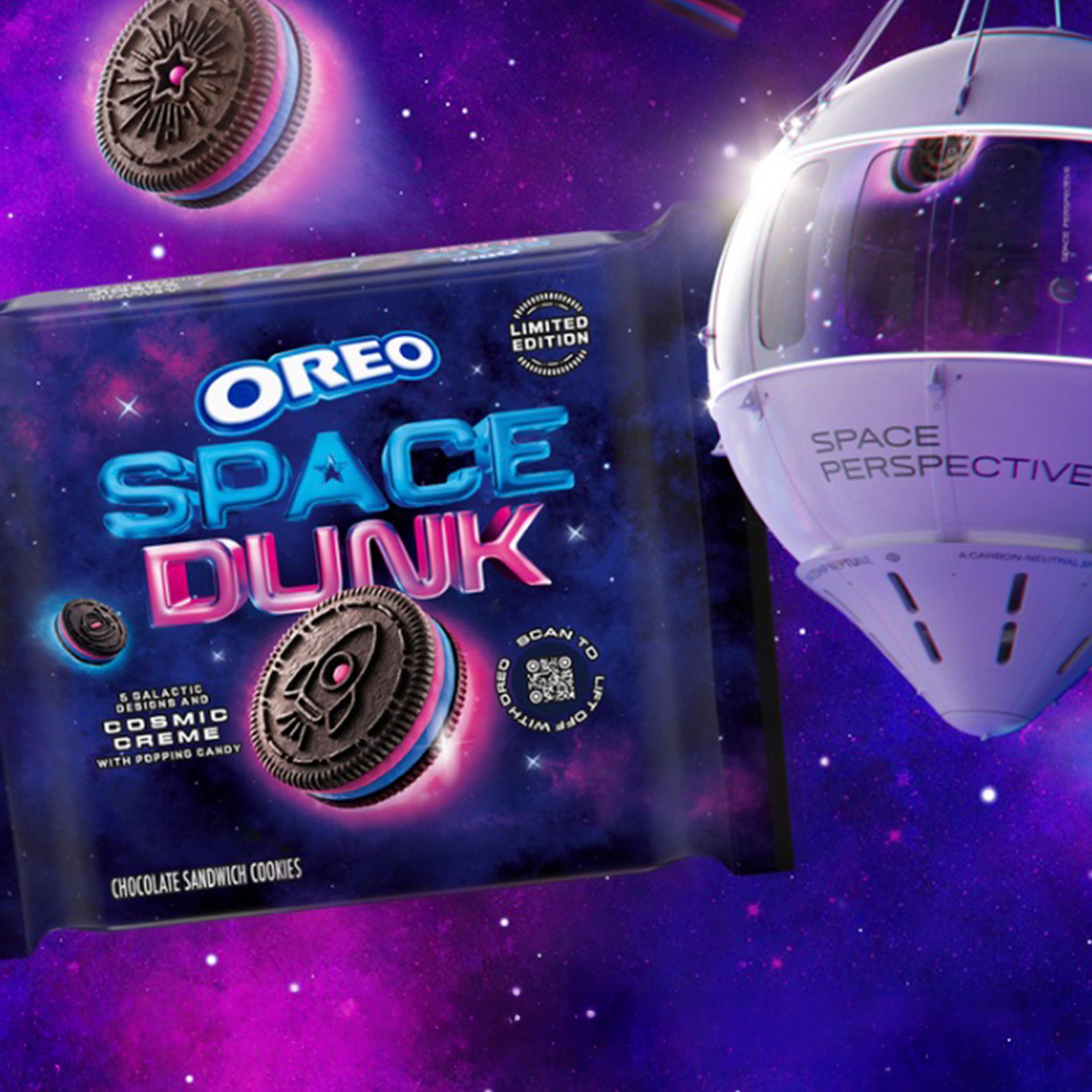
New York Post Features Our OREO Space Dunk Partnership
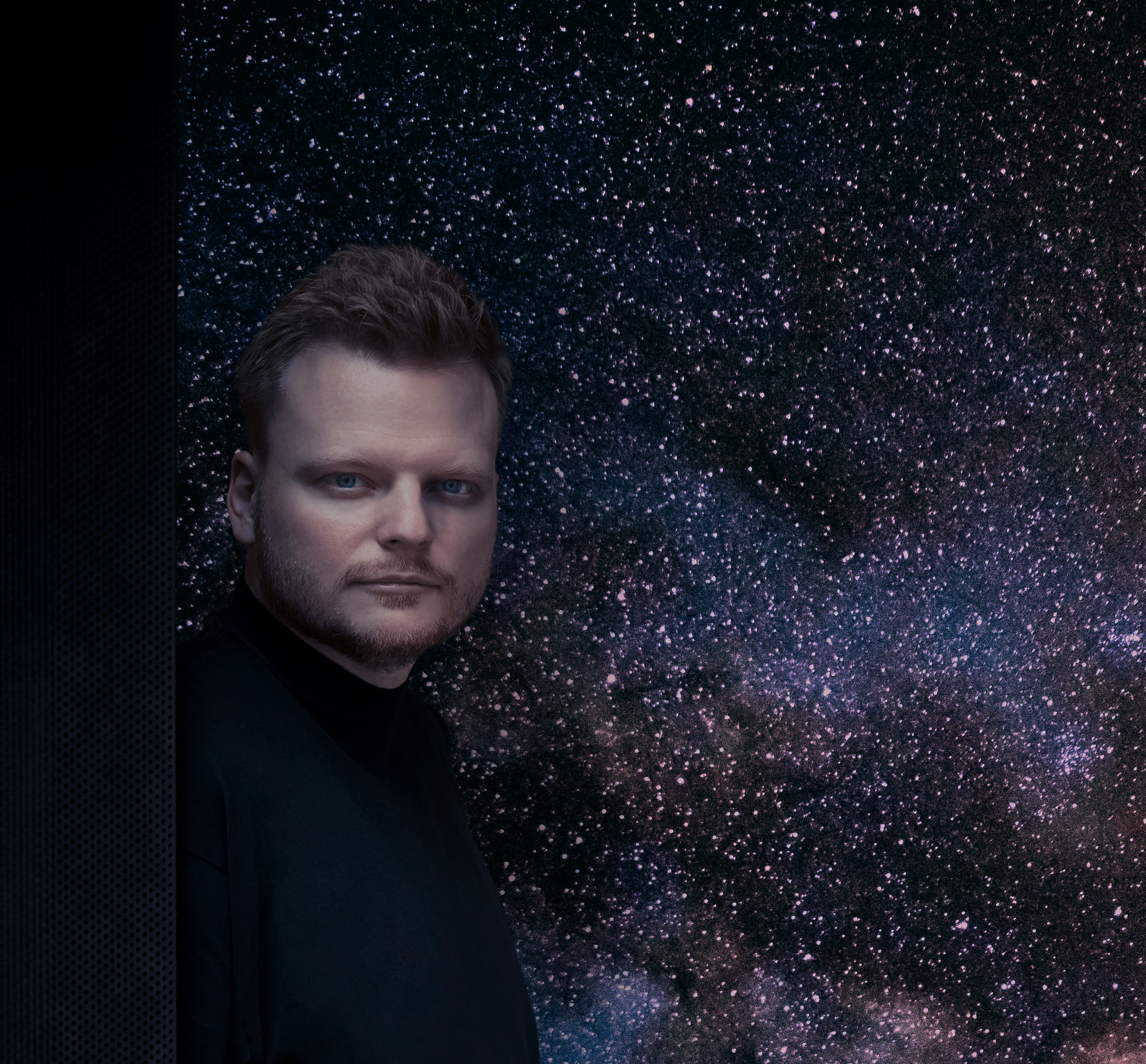
Bloomberg Covers Space Dinner With Michelin-Starred Chef Rasmus

Newsweek Profiles Our Mercedes-Maybach Partnership

"I can close my eyes now and see the view clearly, vividly. That stays with you a lifetime. That changes you." Jeff Hoffman Former NASA astronaut, professor of aerospace engineering at the Massachusetts Institute of Technology (MIT), and Space Perspective Senior Technical Advisor.
- Entertainment
- Awards Shows
- Climate Change
- Nightlife & Dining
- Gift Guides
- Business of Art
- About Observer
- Advertise With Us
Every Space Tourism Package Available in 2021 Ranked: From $125K to $60 Million
From virgin galactic's suborbital ride to spacex's multi-day orbital voyage, we've rounded up every space tourism package available..

2021 is a historic year for commercial space travel. A record number of civilian orbital and suborbital missions launched successfully: Elon Musk ’s SpaceX launched four amateur astronauts into Earth’s orbit for the first time; a Russian film crew spent 12 days on the International Space Station shooting the world’s first movie in space; and two multi-billionaires flew to the edge of Earth’s atmosphere as the first passengers of their respective space companies to show the public that their new spacecrafts are safe and fun.
Sign Up For Our Daily Newsletter
Thank you for signing up!
By clicking submit, you agree to our <a href="http://observermedia.com/terms">terms of service</a> and acknowledge we may use your information to send you emails, product samples, and promotions on this website and other properties. You can opt out anytime.
As with everything in its early stages, space tourism today is unattainably expensive (although demand appears to be strong enough to keep existing companies in this market busy for several years). But eventually, as technology matures and more companies enter the industry, prices will hopefully go down. As a space tourism entrepreneur told Observer this summer, going to space in the future “will be more and more like going to Europe.”
Below, we’ve rounded up every space tourism package that is either available now or in the near future. We have listed them in the order of price and compared them by travel duration, maximum altitude, passenger cabin amenities, and value for money—if you can afford it, that is.
Space Perspective: “Hot Air Balloon” to Stratosphere
Price: $125,000 Flight altitude: 30 kilometers What you’ll get: A relaxing six-hour ride to the stratosphere in a balloon-borne pressurized capsule. Date available: 2024 Value for money: ★★★★ (4/5 stars)

Founded by the team that launched Alan Eustace in 2014 for his Guinness World Record space jump , Florida-based Space Perspective in June began selling tickets of its yet-to-be-licensed “Spaceship Neptune” flights.
A pressurized capsule designed to carry up to eight passengers and one pilot will be slowly lifted by a hydrogen-filled balloon the size of a football field when fully inflated to 19 miles (30 kilometers) in the sky, about three times the altitude of commercial planes. The passenger cabin features a bar, a bathroom and huge windows specially designed for sightseeing.
The balloon will hover at its peak altitude for about two hours before slowly descending to a splashdown in the Atlantic Ocean, where passengers and will be picked up by a recovery ship.
Because the space balloon moves at only 12 miles per hour during ascent and descent, no special training is required before the ride. Space Perspective completed a test flight in June. The company expects to begin flying paying customers before the end of 2024.
Virgin Galactic: Suborbital Joy Ride
Ticket Price: $450,000 Flight altitude: 50 km What you’ll get: A 90-minute ride to 50 kilometers above sea level in a SpaceShipTwo spaceplane. A few minutes of zero-gravity experience during descent. Date available: Now Value for money: ★★ (2/5 stars)

If you like a more thrilling space experience provided by a company with a little bit of a track record, Virgin Galactic (SPCE) ’s 90-minute suborbital flight might be your choice.
In July, the company’s founder, Richard Branson , became its first passenger and flew to the edge of Earth’s atmosphere in a VSS Unity SpaceShipTwo spaceplane along with two pilots and three Virgin Galactic employees.
A pioneer in the nascent space tourism industry, Virgin Galactic began selling seats in 2013 at $250,000 apiece. By the time it halted sales in 2014 (after a test flight failure), the company had collected deposits from more than 600 aspiring customers. Ticket sales resumed in August this year at a higher price of $450,000. Virgin Galactic said it has since received 100 reservations.
Each VSS Unity SpaceShipTwo can carry up to four passengers. Virgin Galactic expects to fly paying passengers three times a month in 2023. At its current reservation volume, it will take the company a number of years to clear its wait list. So, patience is your friend here.
Blue Origin: Quick Rocket Trip to the Kármán line
Ticket Price: Reportedly $28 million Flight altitude: 100 km What you’ll get: A 12-minute ride to the Kármán line, the internationally recognized boundary between Earth’s atmosphere and outer space. Date available: Now Value for money: ★ (1/5 stars)

Blue Origin offers a similar suborbital flight package to Virgin Galactic’s. The main difference is that Virgin flies passengers in a plane while Blue Origin launches amateur astronauts in a real rocket.
On July 20, a few days after Branson’s spaceflight, Jeff Bezos became the first customer of his own space company as well, blasting off to 107 kilometers in the sky in a New Shepard booster-capsule combo. The same spacecraft launched another crew of four passengers, including Star Trek actor William Shatner , on October 13.
Blue Origin began taking reservations in May. The exact ticket price is still a mystery. Bezos has said Blue Origin will price New Shepard flights similarly to its competitors, which led us to speculate that it would likely fall in the range of what Virgin Galactic charges. But, according to Tom Hanks , the ride would cost $28 million, which he said was the reason he turned down Bezos’ invitation to fly on the October mission. Hanks may have been joking, but $28 million was how much an auction winner paid to fly alongside Bezos in July. Of that total, $19 million was donated to various space organizations, Blue Origin said. If the remaining amount went to the company itself, it was still a hefty $9 million.
Blue Origin said it has raked in $100 million from private clients, but refused to disclose how many tickets have been sold.
SpaceX: Multi-Day Orbital Voyage
Ticket Price: Estimated $55 million Flight altitude: 574 km Date available: Now What you’ll get: Three-day stay inside SpaceX’s Dragon capsule circling around Earth with three crew mates. Value for money: ★★★ (3/5 stars)

SpaceX has more experience launching humans into space than any other company in this roundup. Its civilian package, rightfully the most expensive of the bunch, provides the closest experience to true space exploration.
In September, four amateur astronauts blasted off into space in a modified SpaceX Dragon capsule, equipped with a 360-degree glass dome, and spent three days flying in Earth’s orbit. The crewed spacecraft shot up to an altitude of 357 miles, about 100 miles higher than the average orbital altitude of the International Space Station.
The trip was paid for by tech billionaire Jared Isaacman, who was also one of the passengers. SpaceX didn’t disclose the exact amount he paid. It was estimated in the $200 million ballpark, given that NASA pays about $55 million for each seat on SpaceX’s regular crewed missions to the ISS.
Axiom Space/SpaceX: Vacation on International Space Station
Ticket Price: $55 million Flight altitude: 408 km Date available: 2022 What you’ll get: A 10-day trip to the International Space Station, including a weeklong stay in the orbital lab. Value for money: ★★★★★ (5/5 stars)

Next year, another four-person, all-civilian mission is expected to launch with a SpaceX Dragon capsule, this time to actually dock at the International Space Station and let the crew live in the orbital lab for a week. (The Inspiration4 mission stayed in orbit only.)
The trip is marketed by Houston-based Axiom Space , a company led by former NASA official Michael Suffredini. Dubbed Ax-1, the mission will be piloted by former NASA astronaut Michael López-Alegría. Three passengers—Larry Connor, Mark Pathy and Eytan Stibbe—have reportedly paid $55 million each for the remaining seats.
Axiom has three more flights planned in 2022 and 2023. Under NASA’s low Earth orbit commercialization policy, two ISS civilian missions no longer than 30 days are allowed per year. Axiom actually aims to eventually build a stand-alone space station to replace the aging ISS. The first major module is expected to launch in 2024.
Roscosmos: Customized Trip to International Space Station
Ticket Price: $50 million to $60 million Flight altitude: 408 km Date available: Now What you’ll get: A 12-day trip to the International Space Station. Value for money: ★★★★★ (5/5 stars)

If you don’t feel like buying your first space trip from an inexperienced private company, Russia’s national space agency Roscosmos has a ISS getaway package very similar to what Axiom and SpaceX have to offer.
In October, Roscosmos sent an actress and a director to the ISS for a 12-day trip to shoot scenes for what will be the first movie filmed in space. On December 8, another civilian, Japanese billionaire Yusaku Maezawa, known for having booked a SpaceX Starship flight around the moon in 2023, will travel to the ISS in a Russian Soyuz MS-20 spacecraft, set to launch from the Baikonur Cosmodrome in Kazakhstan.
Maezawa will fly with his assistant, Yozo Hirano, and Russian cosmonaut Alexander Misurkin. According to Space Adventures , a Virginia-based company currently working with Roscosmos on future commercial flights, a seat on an ISS-bound Soyuz spacecraft will cost in the range of $50 million to $60 million.

- SEE ALSO : What Melinda French Gates’s Philanthropy Could Look Like Post-Gates Foundation
We noticed you're using an ad blocker.
We get it: you like to have control of your own internet experience. But advertising revenue helps support our journalism. To read our full stories, please turn off your ad blocker. We'd really appreciate it.
How Do I Whitelist Observer?
Below are steps you can take in order to whitelist Observer.com on your browser:
For Adblock:
Click the AdBlock button on your browser and select Don't run on pages on this domain .
For Adblock Plus on Google Chrome:
Click the AdBlock Plus button on your browser and select Enabled on this site.
For Adblock Plus on Firefox:
Click the AdBlock Plus button on your browser and select Disable on Observer.com.
Space Voyages: Affordable Journeys Beyond Imagination

Experience the cosmos with the International Space Travel Bureau (ISTB), your gateway to affordable, unforgettable interplanetary travels and best-value space journey packages on earth and beyond
Thank you for subscribing
Thank you for your purchase. You'll receive an email shortly.
Space Reviews
What our space travellers say
The tour exceeded all my expectations, from the smooth take-off at Kennedy Space Center to the breathtaking views of Earth from the moon. The crew was professional and ensured our safety and comfort throughout the journey. I highly recommend this once-in-a-lifetime space travel adventure!
Saturnee Rajasamy
My trip to Mars was absolutely worth every penny! The journey was thrilling, and the views of the red planet left me speechless. Despite a minor issue with communication back on Earth, the onboard amenities were excellent, and I enjoyed delicious meals. If you’re a space enthusiast seeking an unforgettable adventure, this is it!
Marsan Arifin
Embarking on a space journey was an experience like no other! The launch was thrilling, and watching Earth shrink behind us was awe-inspiring. Although there were a few technical glitches and some discomfort, the trip to the asteroid belt was truly spectacular. Overall, it was an adventure I’m glad I took part in.
Space travel packages, interplanetary tours.

Space Hubs Indulgence

Flyby Exploration

Subscribe to our newsletter
Obtain our most recent events and advancements
Explore Our Virtual Tours: Plan Your Itinerary
Come meet with our space travel advisor at our virtual Lunar Base Lounge

Explore cosmos affordable with our packages

International Space Travel Bureau, a collaboration agency with NASA, pioneers in designing unprecedented experiences beyond the earth's boundaries. We aim to make the cosmos more accessible, offering affordably priced, fully-customizable space travel packages that transport you to unimaginable destinations. Step into the future of tourism with us, where quality service meets cosmic exploration
Plan Your Space Travel With Our ISTB App
Talk to our space travel advisors and experts. Join our space travel community and explore our zero G space lab

Contact Space Voyages
Unleash your curiosity, expand your horizons, and step into the extraordinary realm of outer space travel by connecting with our International Space Travel Bureau — Submit your information now

What physical and health prerequisites are needed for participating in space travel?
To partake in this extraordinary adventure, passengers need to be in sound health and physical condition, be able to handle the rigors of launch, re-entry forces, and potential lunar gravity if partaking in our Moon base program. Individual requirements may vary depending on the specific mission.
What is the duration of various space tours offered?
The duration differs based on the mission type. Flyby explorations typically last a few hours, a trip to our Moon base can last up to a week, and the asteroid staging hub visit may extend to several weeks, inclusive of preparation and travel time
How does the company ensure safety in space tourism?
Safety is our utmost priority. All spacecraft undergo meticulous testing and regular maintenance. Passengers are trained thoroughly in safety procedures and are always accompanied by seasoned astronauts. We comply with all international standards for space travel.
What kind of pre-journey training is required?
All passengers must complete a pre-flight training regimen that includes physical fitness, safety protocols, understanding spacecraft operations, and emergency preparedness. The content and duration of training depend on mission specifics
How far into space do the different tours travel?
Flyby tours explore low Earth orbit around 100 kilometers (62 miles) above the Earth’s surface. The lunar tours travel approximately 385,000 kilometers (239,000 miles) to our Moon base, while the asteroid tours or other planetary flybys journey even further into space to our staging hubs and beyond
What can passengers expect to see and experience during various space tours?
Depending on the tour, passengers can experience weightlessness, witness Earth from space, explore the lunar surface, in-base activities and entertainments or engage in asteroid mining activities at our staging hubs. Each tour offers unique views and experiences
What is the cost of different space tours? Are there flexible payment options?
The cost varies significantly based on the journey specifics. We provide various payment plans to accommodate different budgets and financial scenarios. You can check out our deal page and its popular tour packages. We even offer 24 months interest-free instalment !
Are there age restrictions for space travel?
Yes, passengers must be at least 18 years old to participate. There’s no upper age limit but physical health requirements must be met. Our deals come with free insurance.
How does one book and schedule a space tour?
Space tours can be booked via our website or by contacting our customer service team directly. Post-booking, passengers will receive detailed information about their training schedule, launch date, and other mission specifics
What contingency plans are in place for technical difficulties or unforeseen circumstances during the journey?
We have comprehensive contingency plans for various scenarios, including safe return protocols if a mission needs to be aborted prematurely. Our spacecraft are equipped with multiple redundant systems to ensure passenger safety in case of any technical difficulties. All our astronauts and technical experts are professionally trained and NASA certified
"Reimagining Past, Remembering Future"
International Space Travel Bureau. A NASA Space Apps Challenge project by Socralytics

Suggested Searches
- Climate Change
- Expedition 64
- Mars perseverance
- SpaceX Crew-2
- International Space Station
- View All Topics A-Z
Humans in Space
Earth & climate, the solar system, the universe, aeronautics, learning resources, news & events.
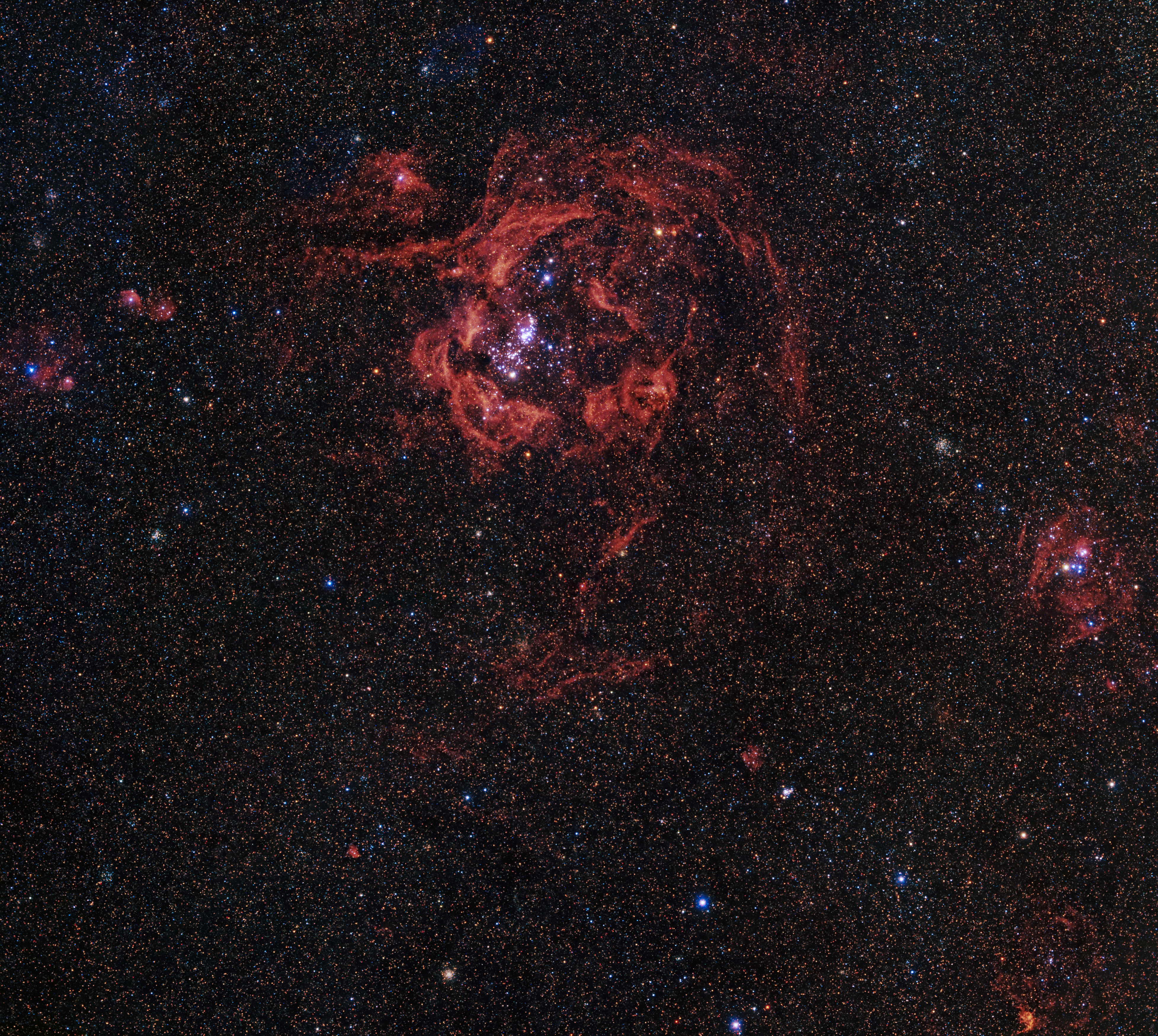
Hubble Zooms into the Rosy Tendrils of Andromeda
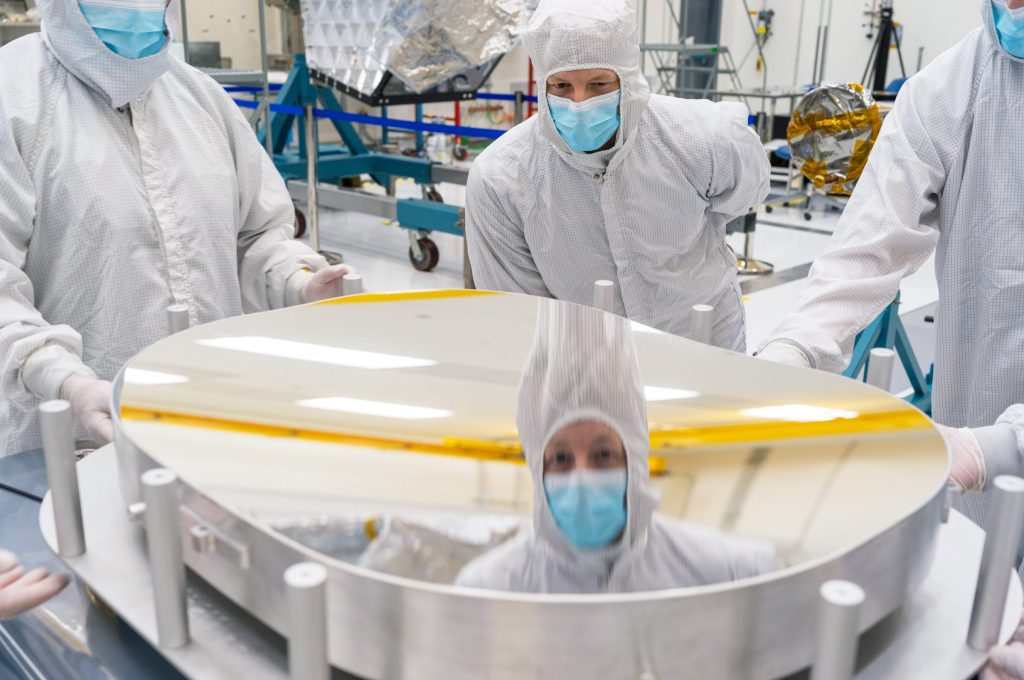
Work Is Under Way on NASA’s Next-Generation Asteroid Hunter

NASA’s Roman Space Telescope to Investigate Galactic Fossils
- Search All NASA Missions
- A to Z List of Missions
- Upcoming Launches and Landings
- Spaceships and Rockets
- Communicating with Missions
- James Webb Space Telescope
- Hubble Space Telescope
- Why Go to Space
- Commercial Space
- Destinations
- Living in Space
- Explore Earth Science
- Earth, Our Planet
- Earth Science in Action
- Earth Multimedia
- Earth Science Researchers
- Pluto & Dwarf Planets
- Asteroids, Comets & Meteors
- The Kuiper Belt
- The Oort Cloud
- Skywatching
- The Search for Life in the Universe
- Black Holes
- The Big Bang
- Dark Energy & Dark Matter
- Earth Science
- Planetary Science
- Astrophysics & Space Science
- The Sun & Heliophysics
- Biological & Physical Sciences
- Lunar Science
- Citizen Science
- Astromaterials
- Aeronautics Research
- Human Space Travel Research
- Science in the Air
- NASA Aircraft
- Flight Innovation
- Supersonic Flight
- Air Traffic Solutions
- Green Aviation Tech
- Drones & You
- Technology Transfer & Spinoffs
- Space Travel Technology
- Technology Living in Space
- Manufacturing and Materials
- Science Instruments
- For Kids and Students
- For Educators
- For Colleges and Universities
- For Professionals
- Science for Everyone
- Requests for Exhibits, Artifacts, or Speakers
- STEM Engagement at NASA
- NASA's Impacts
- Centers and Facilities
- Directorates
- Organizations
- People of NASA
- Internships
- Our History
- Doing Business with NASA
- Get Involved
NASA en Español
- Aeronáutica
- Ciencias Terrestres
- Sistema Solar
- All NASA News
- Video Series on NASA+
- Newsletters
- Social Media
- Media Resources
- Upcoming Launches & Landings
- Virtual Guest Program
- Image of the Day
- Sounds and Ringtones
- Interactives
- STEM Multimedia
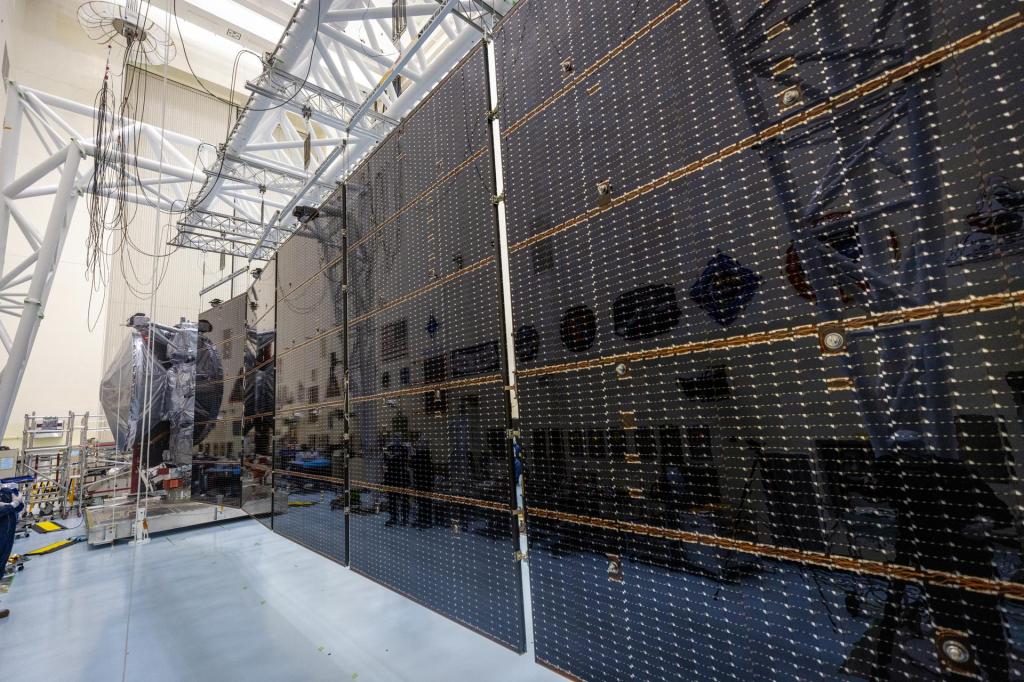
NASA’s Europa Clipper Gets Set of Super-Size Solar Arrays

FAQ: NASA’s Boeing Crew Flight Test Return Status

NASA, Boeing Optimizing Vehicle Assembly Building High Bay for Future SLS Stage Production

NASA Seeks Input for Astrobee Free-flying Space Robots

NASA Funds Studies to Support Crew Performance on Long-Duration Missions

NASA JPL Developing Underwater Robots to Venture Deep Below Polar Ice
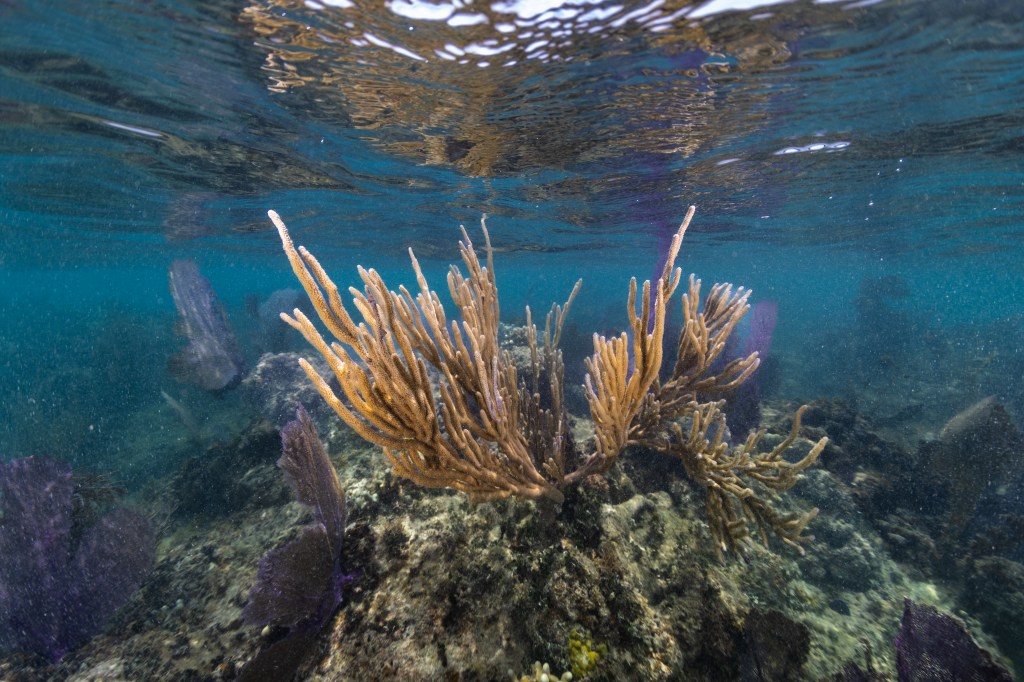
NASA Project in Puerto Rico Trains Students in Marine Biology
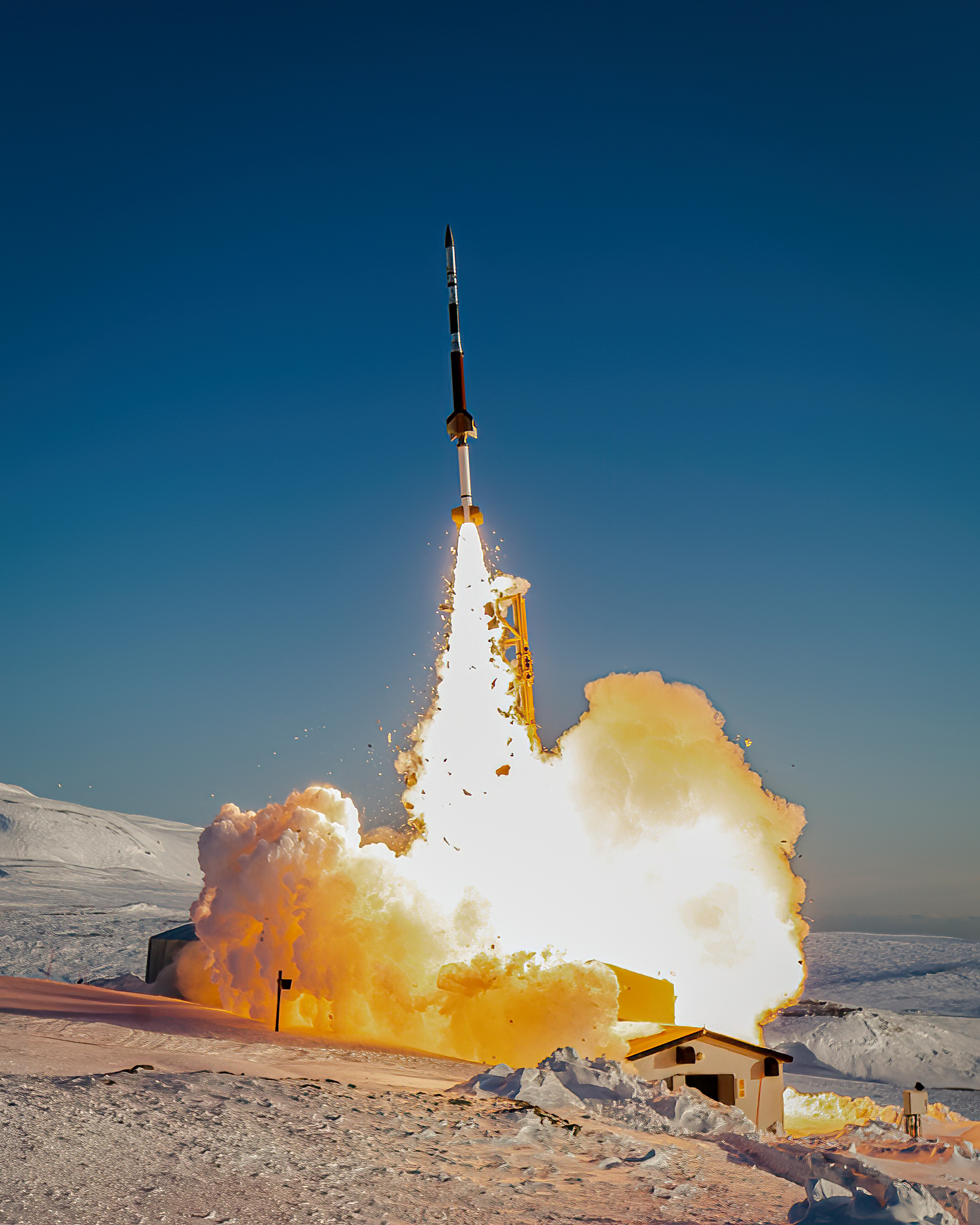
NASA Discovers a Long-Sought Global Electric Field on Earth
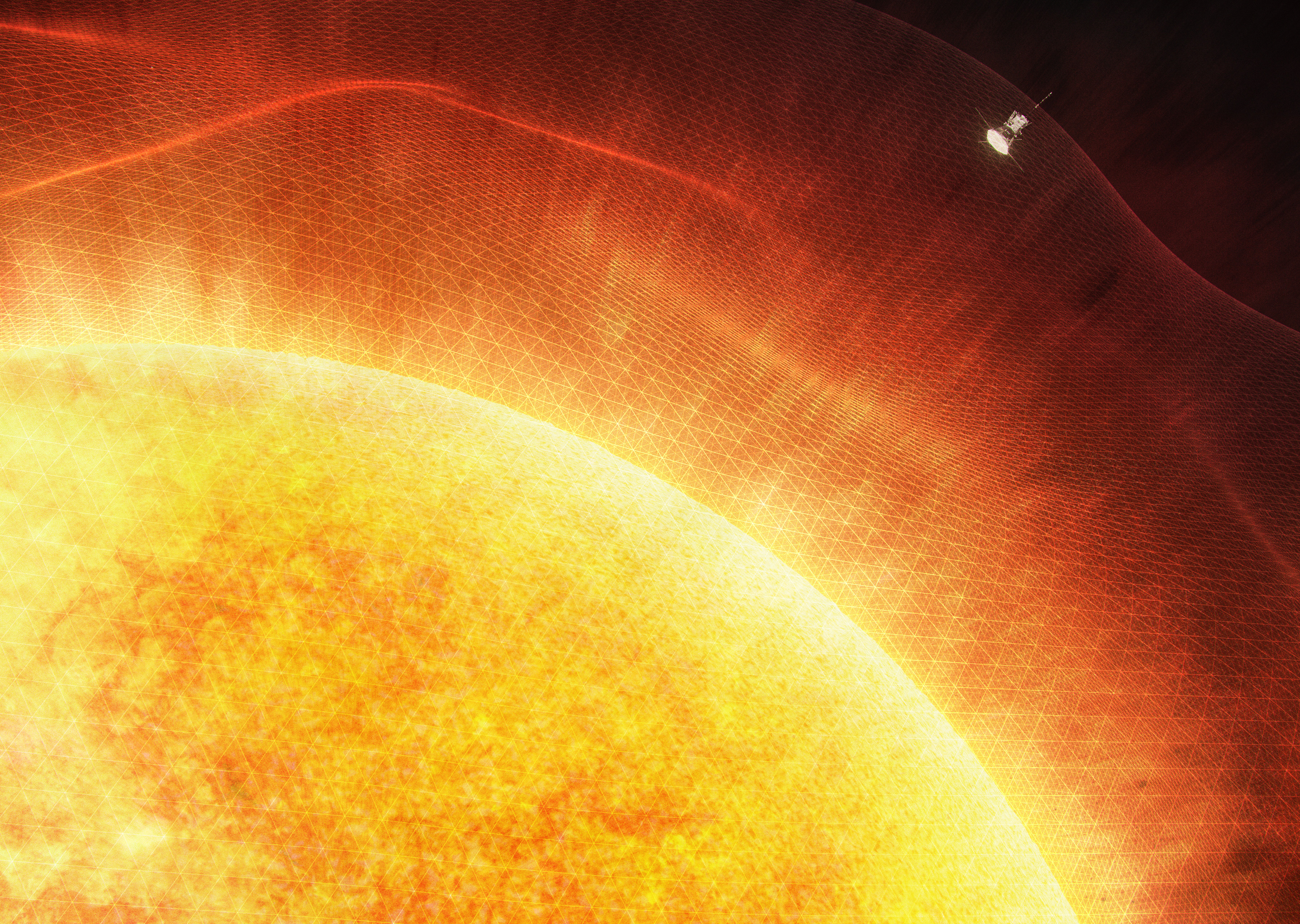
NASA, ESA Missions Help Scientists Uncover How Solar Wind Gets Energy
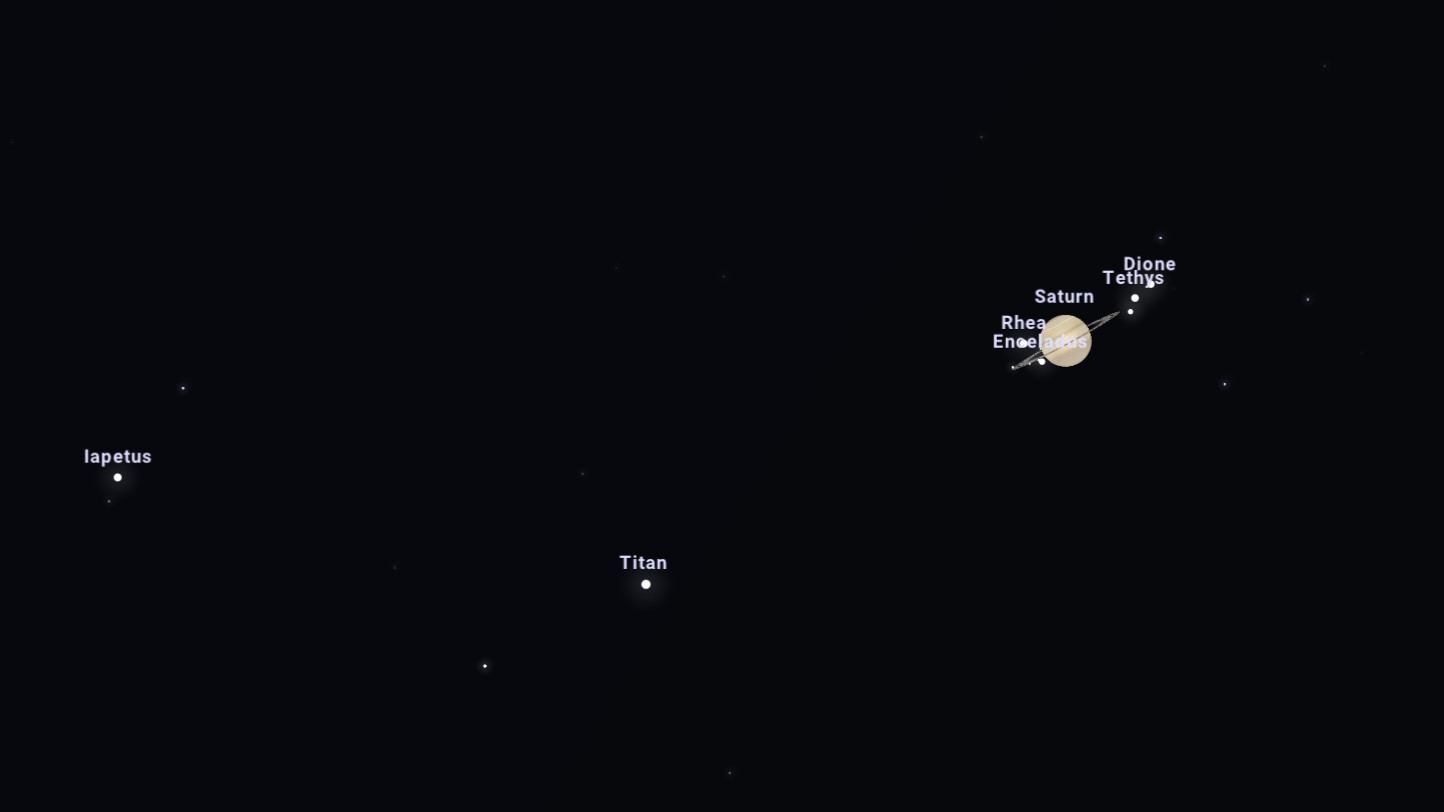
September’s Night Sky Notes: Marvelous Moons

Amendment 45: New Opportunity: A.60 Ecological Conservation

NASA G-IV Plane Will Carry Next-Generation Science Instrument
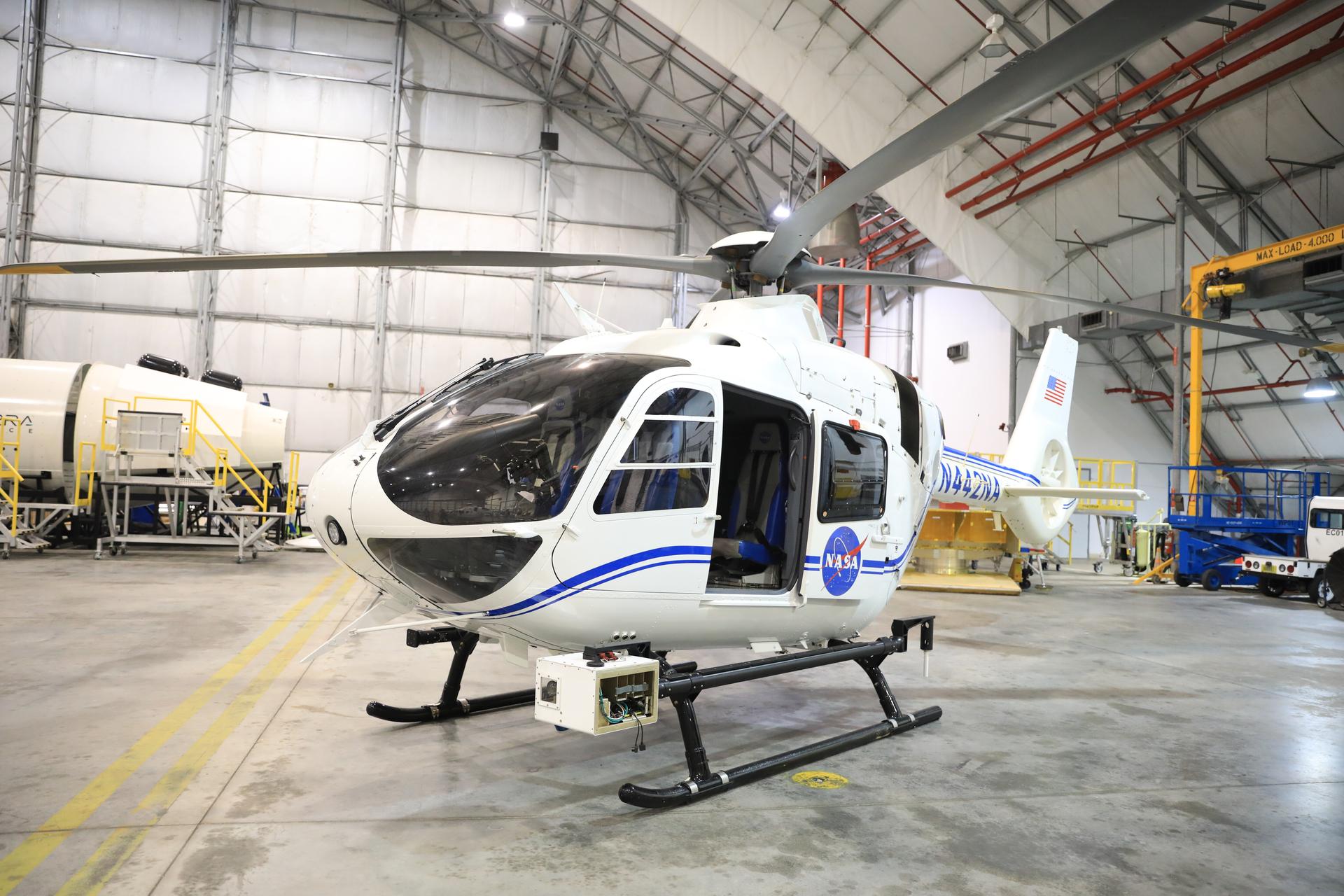
NASA Develops Pod to Help Autonomous Aircraft Operators
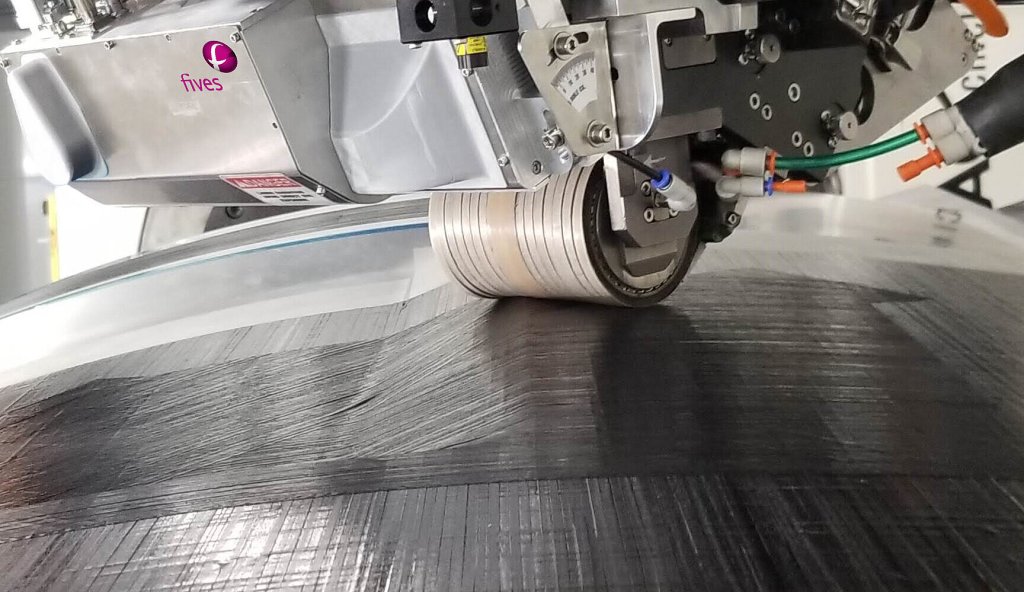
NASA Composite Manufacturing Initiative Gains Two New Members
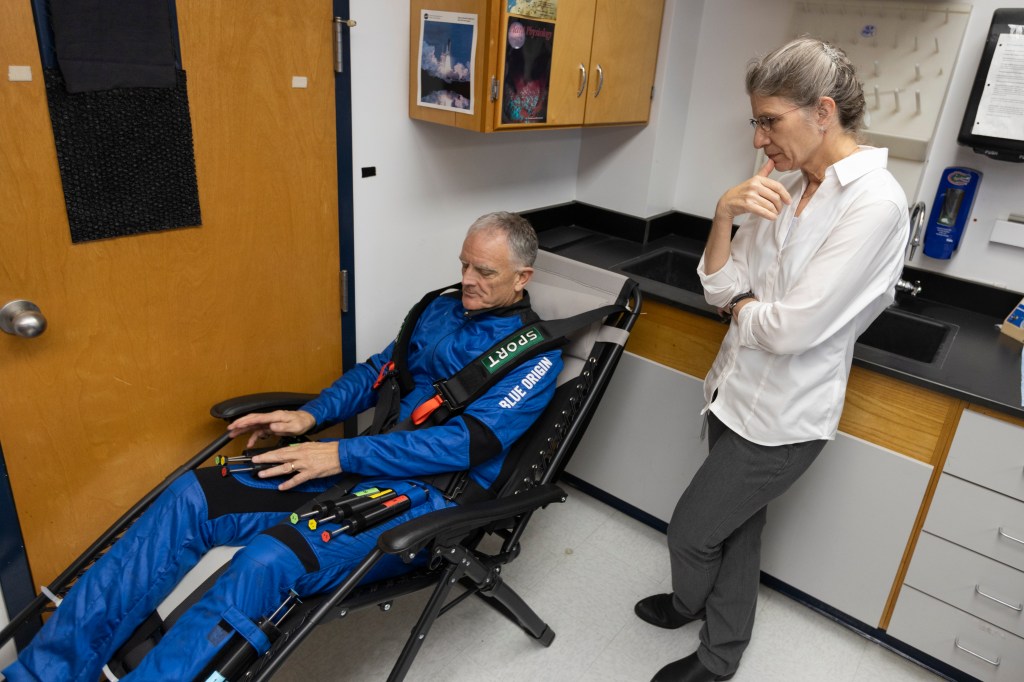
First NASA-Supported Researcher to Fly on Suborbital Rocket

How Do I Navigate NASA Learning Resources and Opportunities?
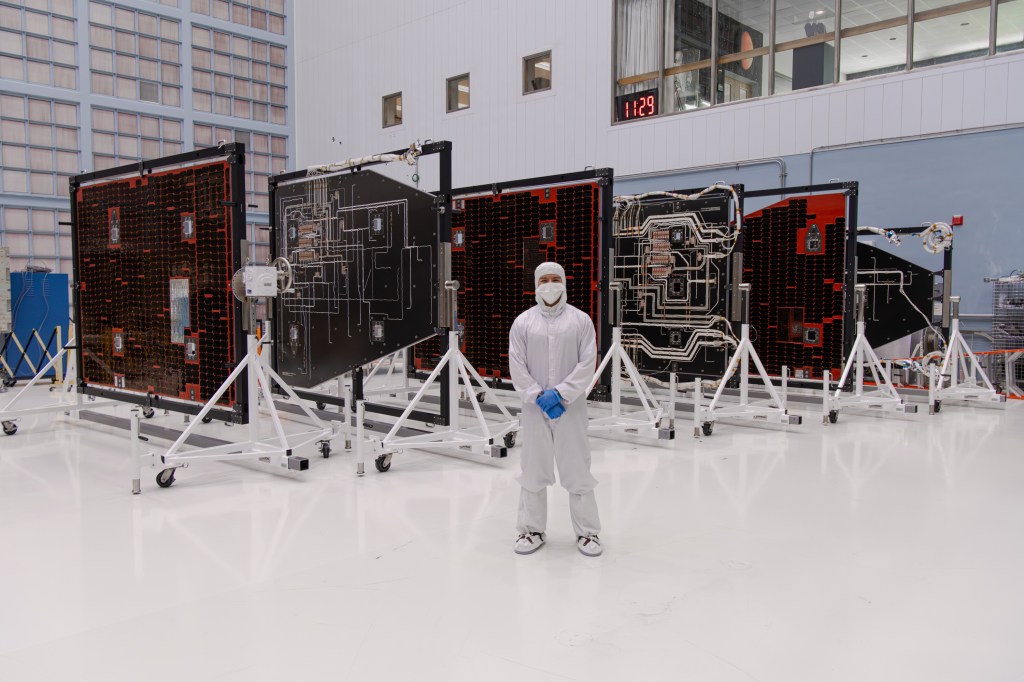
Aaron Vigil Helps Give SASS to Roman Space Telescope
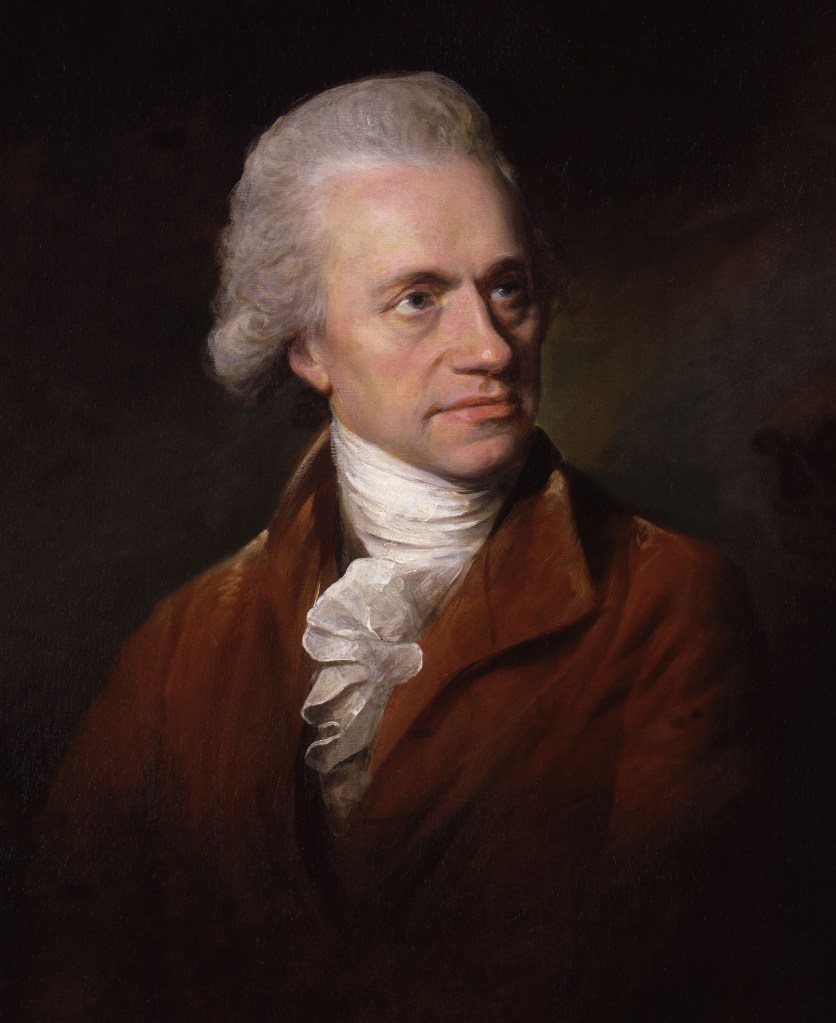
235 Years Ago: Herschel Discovers Saturn’s Moon Enceladus
Preguntas frecuentes: estado del retorno de la prueba de vuelo tripulado boeing de la nasa.

Astronauta de la NASA Frank Rubio


Diez maneras en que los estudiantes pueden prepararse para ser astronautas
Artemis i travel essentials: the ultimate personal tour guide for your trip to the moon.
Michael Bock
1.) get your passport and look up your boarding pass , 2.) do a little research , 3.) pack for your trip , 4.) check out your accommodations , 5.) plot your route , 6.) before you leave… .
The Moon. Earth’s most famous natural satellite … and your new travel destination.
From its wide vistas and secluded craters, to its unbeatable views of our own planet, visiting the Moon is a must-see for every well-seasoned space traveler’s bucket list. Lunar adventures have been quite popular among uncrewed spacecraft in recent years, but it’s been a generation since humans have set foot on the lunar surface. That is changing with NASA’s Artemis missions.
This year, NASA is embarking on an exciting journey to the Moon—and we’re inviting you to come along*.
Artemis I is an uncrewed flight test that will lay the foundation for a sustained long-term presence on and around the Moon. Launching this summer, the Space Launch System (SLS) rocket and integrated Orion spacecraft will help us get a feel for what astronauts will experience on future flights. Artemis I is an important step in NASA’s long-term goals for space exploration, paving the way for us to land the first woman and the first person of color on the Moon, explore more of the lunar surface than ever before — and prepare to travel on to Mars.
This handy travel guide is designed to help everyone from space travel rookies to seasoned galactic explorers figure out exactly what to see, what to bring, and how to get ready as we return to the Moon.
Before you book your ticket, make you sure you get your Artemis passport ready! Join the virtual guest list for Artemis launches and receive a special Artemis I virtual guest passport and stamp after launch along with mission updates and interactive opportunities. Over 300,000+ virtual guests from around the world have already joined!
If you were one of the 3 million people who submitted your name to be flown around the Moon aboard the Orion spacecraft, you can look up your boarding pass and print or download it at your leisure. If you didn’t submit your name, don’t worry — you can still download and fill out a blank boarding pass!
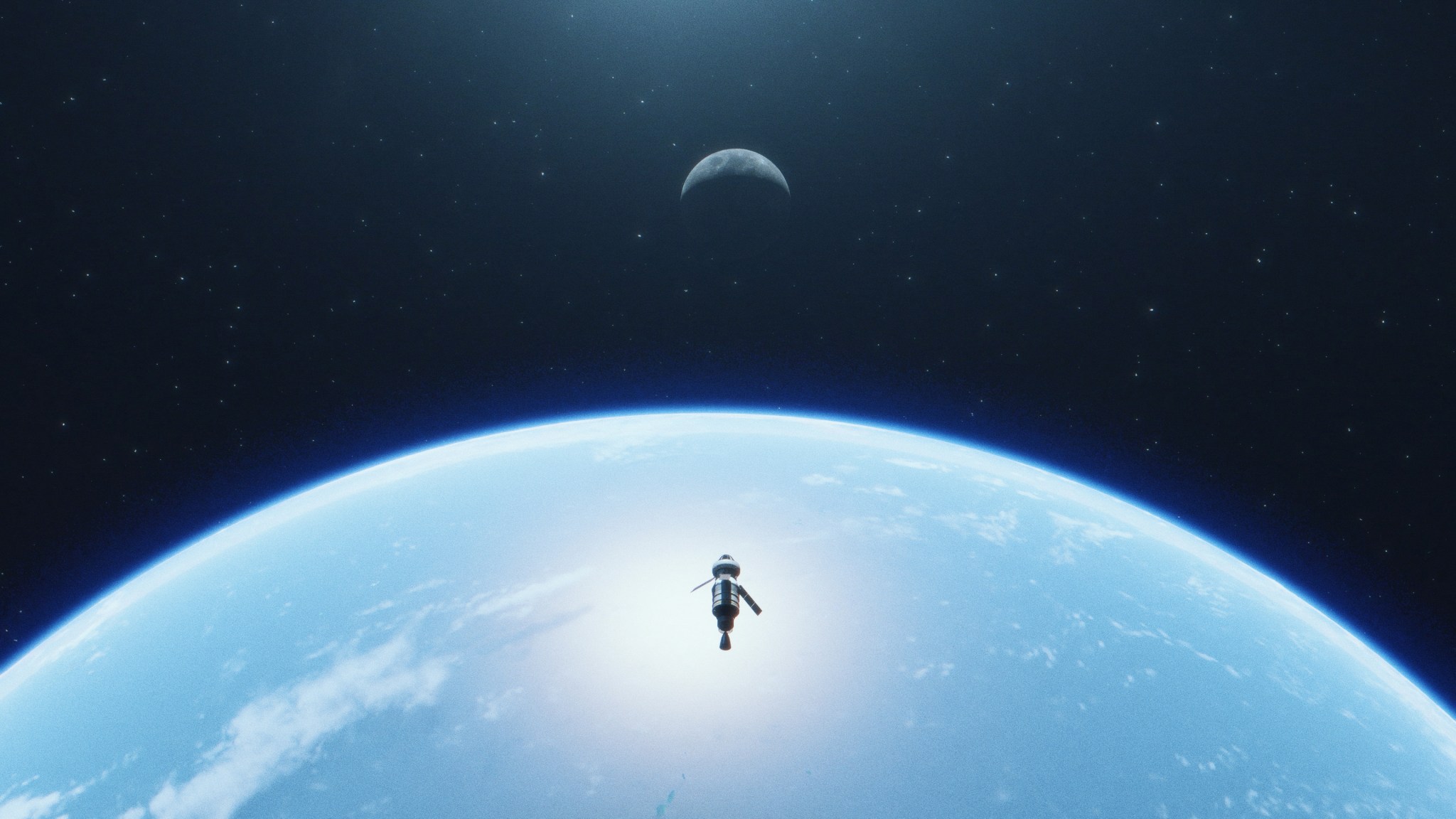
Since you’re headed to the Moon, here is your opportunity to check out images and content about the Moon and then create your own! Submit your #NASAMoonSnap and we will be featuring some entries during the launch broadcast or on NASA’s social media.
Artemis I will blast off from NASA’s spaceport at Kennedy Space Center and fly farther than any spacecraft built for humans has ever flown. Watch a preview of your flight to get the highlights of the mission.
You’ve got your papers sorted — now it’s time to put together your packing list ! Take a look at what others have decided they would pack for the Moon, including astronauts , NASA photographers , and other creative people like you !
Grab some reading materials. While you’re sure to get some incredible window views as the Orion spacecraft travels thousands of miles beyond the Moon, you’ll likely want some entertainment during the 4-6 week mission. If you’re looking for some reading material, check the First Woman graphic novel, the You Are Going children’s book, and the Moonikin webcomic .
And set a playlist. No trip is complete without a playlist! Check out the NASA Moon Tunes playlist put together by Third Rock Radio and compiled from over a million votes all around the world. And if podcasts are more your speed, check out this curated Artemis podcast playlist on Soundcloud.
You’ll be flying in comfort aboard Orion, the spacecraft that will take astronauts to the Moon on future Artemis missions. Among the science, research equipment, and mementos you’ll be travelling with are Commander Moonikin Campos, Helga, and Zohar. These human-bodied manikins are gathering important data for future missions— read their story here .
Following along at home? You can decorate the walls of your own ‘crew cabin’ with our beautiful travel destination posters :
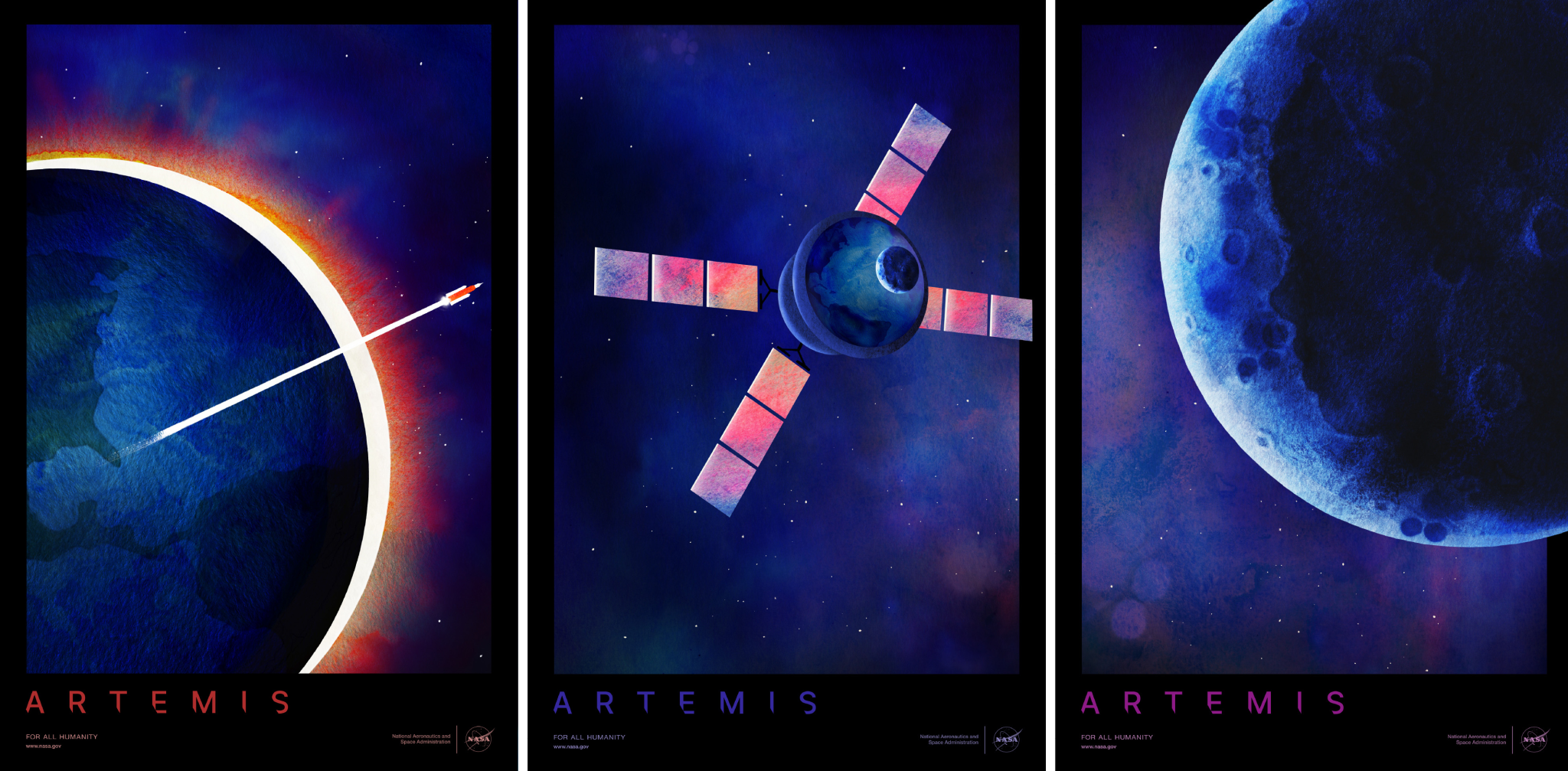
Download Artemis: Visionary (8.07 MB) | Download Artemis: Courageous (7.31 MB) | Download Artemis: Galvanizing (8.98 MB)
Before heading out, you’ll want to familiarize yourself with your route . That’s why we’ve put together a flight map with important milestones you’ll reach on your trip beyond the Moon and back.
Our travel itinerary will bring us within about 60 miles of the Moon’s surface—a prime opportunity for sightseeing. Learn more about your destination on our Moon site .
Can’t wait to see the SLS rocket on the launch pad? Picture it in your own backyard! Try out our Snapchat AR Lens: Backyard Rocket and see how the launch would appear from the mission control room at Kennedy Space Center.
And know where to track your flight . Once you’re on your way to join the Artemis I mission, you can follow along with telemetry updates and see exactly where Orion is every step of the journey.
However you choose to follow along our journey, we’re glad to have you with us. Be sure to follow @NASAArtemis on Facebook , Twitter , and Instagram , or subscribe to our newsletter to get the latest updates as we prepare for our next great era of discovery.
* DISCLAIMER: As much as we’d like to bring everyone aboard Orion for a flight around the Moon, Artemis I is an uncrewed mission. So please enjoy the next best thing: free and fun activities that you can participate in from the comfort of your own home.
- Search Please fill out this field.
- Newsletters
- Travel News
Everything You Need to Know About Space Tourism Right Now
Your next travel splurge could be a flight to space
:max_bytes(150000):strip_icc():format(webp)/StefanieWaldek-38071ba574ea46c2ac94e15fa18dc581.jpg)
Virgin Galactic vehicle SpaceShipTwo on its first glide flight on October 10, 2010 over Mojave in California. (Virgin Galactic / Getty Images)
While 2020 has been an abysmal year on many counts, there’s one industry that’s thriving: space exploration. Within the first eight months of the year, we’ve seen the successful launches of three Mars missions, promising tests of new rockets, and the return of crewed spaceflight to U.S. soil—aboard a privately built spacecraft, no less! But we’re also getting much closer to the launch of the space tourism industry, meaning your dream of becoming an astronaut could become reality quite soon. We’re still a little ways away from regular flights into space for paying customers, but here are all the developments you need to know about.
The History of Space Tourism
Traveling to space has long been the domain of professional astronauts, not ordinary citizens. But that all changed when American entrepreneur Dennis Tito flew to space in 2001 with space tourism company Space Adventures, who organized the trip with Russian space agency Roscosmos. Tito was the first of only seven true “space tourists,” each of whom traveled to the International Space Station (ISS) via Roscosmos's Soyuz spacecraft for about a weeklong stay—or for two separate weeklong stays, in the case of one space traveler—for a reported cost between $20 million to $35 million per trip (plus months of training). The final space tourism excursion was made by Cirque du Soleil founder Guy Laliberté in 2009, after which Roscosmos had to end touristic flights: when NASA retired its space shuttle program in 2011, each seat on its Soyuz spacecraft needed to be reserved for crews heading to the ISS, not tourists. Since then, space tourism has been halted.
Nearly There: Blue Origin and Virgin Galactic
The issue with Space Adventure’s program is that it relies on other operators for transportation, which limits its access to space. But the next wave of private spaceflight companies have been developing their own vehicles to propel clients into weightlessness. The two frontrunners in the space tourism race are Jeff Bezos’s Blue Origin and Sir Richard Branson’s Virgin Galactic, both of which are in advanced testing phases—Virgin Galactic has even opened ticket sales already, with more than 600 passengers booked. While both aerospace companies will provide their clients with suborbital trips into space, they’ll do so in entirely different fashions.
Blue Origin
Blue Origin plans to send tourists to space in its New Shepard vehicle, named after the first American in space, Alan Shepard, from its launch site in West Texas. New Shepard, which is an entirely autonomous craft that doesn’t need a human pilot, is similar to Roscosmos’s Soyuz and SpaceX’s Crew Dragon vehicles in that its six passengers will be housed in a capsule and vertically launched into space via a rocket.
After a day of training, passengers will get to experience a launch just as professional astronauts do: they’ll feel the intense G-forces pressing down on them as the rocket shuttles them to an altitude of approximately 62 miles, which is widely accepted as the boundary of space. When the engines cut off, passengers will be weightless, and they’re free to float about the capsule, taking in the views of the planet and of the darkness of space through the capsule’s large windows. After a few minutes, the capsule will fall back to Earth under parachutes. All in, the trip lasts just 11 minutes—it’s a pretty short flight considering tickets will likely cost about $250,000.
Blue Origin has successfully launched New Shepard on 12 un-crewed test flights since 2015, but it’ll need to get humans up into space before it’ll be certified to start carrying paying customers. The company originally hoped to launch a crewed test flight in 2019; however, it still has not done so, nor has it announced a new timeline for the test.
Virgin Galactic
Virgin Galactic, on the other hand, will fly passengers to space aboard a winged vehicle called SpaceShipTwo , which bears similarities to NASA’s space shuttle. But whereas the shuttle launched vertically via a rocket, SpaceShipTwo is launched horizontally. The vehicle, which seats six passengers plus two pilots, takes off from a runway like a regular plane via its carrier aircraft called WhiteKnightTwo. Virgin Galactic currently launches from the Mojave Air and Space Port in California, but it will also launch from Spaceport America in New Mexico.
After takeoff, WhiteKnightTwo ascends to 50,000 feet, after which SpaceShipTwo is released, and its rocket-powered engines kick in to bring it all the way to a maximum altitude of roughly 68 miles. As with Blue Origin’s New Shepard, passengers will enjoy a few minutes of weightlessness before returning to Earth, but instead of a parachute landing, SpaceShipTwo will land on a runway like a plane—which is also how the space shuttle landed. Total run time: between two and three hours in flight, plus two-and-a-half days of training, with a price tag of $250,000.
Virgin Galactic has been conducting test flights since 2010, but progress has been a bit slow—and deadly. In 2014, a test pilot was killed after a SpaceShipTwo vehicle broke apart during a flight, primarily due to pilot error. Testing resumed in 2016 and is ongoing, with no official word on when commercial operations will begin.
Other Companies Dreaming Big
Of all the space tourism operations out there, Blue Origin and Virgin Galactic are by far the closest to launching passengers. (Elon Musk's SpaceX, which has already successfully launched NASA astronauts into space, is not focusing on tourism, though it will provide lifts for third-party companies.) But coming in hot on their heels is Boeing, whose Starliner vehicle is being developed for NASA's Commercial Crew Program; its contract, however, allows for tourists to potentially join flights.
The other viable space tourism companies on the horizon are not developing their own vehicles, rather, they plan on hitching rides with other providers. Space Adventures is still in the game, having entered a partnership with SpaceX to fly passengers on Crew Dragon as soon as next year. It’s also revived its tourism operations with Roscosmos: two tourists are booked on a trip to the ISS in 2023. Another company, Axiom Space, plans on taking passengers to the ISS via SpaceX’s Crew Dragon as soon as 2021, before launching its own private space station by the end of the decade. Similarly, Orion Span has announced its intentions to launch its Aurora Space Station in 2021, though construction on the project has yet to begin.
Related Articles
More related articles.
- Search Please fill out this field.
- Manage Your Subscription
- Give a Gift Subscription
- Newsletters
- Sweepstakes
- Space Travel + Astronomy
Space Tourism Is Here: Booking a Trip to the Final Frontier
The next era of space exploration and innovation is here — and we're all invited. Space tourism is officially taking flight, and it might just save the Earth.
:max_bytes(150000):strip_icc():format(webp)/Jamie-Carter-618d9aa6e45f4ecf9b9dcaabbec68029.jpg)
In July 2021, we watched as Richard Branson and Jeff Bezos took to the skies in a giant leap for the space tourism industry, but their launches to the edge of space weren't timed particularly well. Against the backdrop of a global pandemic and climate emergency, two billionaires taking joy rides to space may not have been good optics, but don't underestimate what happened — and how important it could be for the future of humanity.
With the first crewed launches of Virgin Galactic's supersonic space plane and Blue Origin's reusable rocket, a world of commercial space travel is taking its first step. Both companies plan to begin regular, scheduled trips for paying space tourists in the near future, but their visions stretch back many years to the beginning of human spaceflight.
The Space Race: Then and Now
Bezos's Blue Origin chose an auspicious day to send its first crew to space. July 20, 2021 was exactly 52 years after Apollo 11 astronauts Neil Armstrong and Buzz Aldrin became the first humans to walk on the moon. But that wasn't the only major space travel anniversary celebrated in 2021.
April 12 was the 60th anniversary of Russian cosmonaut Yuri Gagarin becoming the first human to not only reach space, but also go into orbit around Earth. Meanwhile, May 5 saw the 60th anniversary of NASA's Freedom 7 mission, which launched Alan Shepard on a suborbital flight that lasted 15 minutes. He reached an altitude of 101 miles to become the first American in space before his capsule parachuted to splashdown in the ocean.
The name of Blue Origin's New Shepard launch system is no coincidence. Its mission profile is almost identical to America's inaugural 1961 spaceflight, save for billionaire-grade comfy seats and large windows. From Launch Site One near Van Horn in the West Texas desert, that rocket fires a capsule containing up to six people (but no pilot) into space, which then parachutes down 15 minutes later.
The Virgin Galactic experience is different. Its supersonic rocket-powered spaceplane SpaceShipTwo VSS Unity seats six passengers and two highly trained pilots. It takes off on a runway from Spaceport America near Truth or Consequences, New Mexico, while strapped to a mothership. At 52,000 feet, it detaches and burns its rocket engine for one minute to reach Mach 3 speeds and touch the edge of space. After a few minutes of weightlessness (and a chance for passengers to see the curvature of Earth against the blackness of space), it glides back to land on a runway.
The Price for a Ticket to Space
These short trips cost between $250,000 and $500,000, but in April 2022, a truly out-of-this-world private trip to space launched with an even more astronomical price tag. It came from the other billionaire in the space tourism bubble: Elon Musk. Axiom Mission 1 saw his company, SpaceX, launch four private astronauts on behalf of Houston-based space tourism company Axiom Space. An American real estate investor, a Canadian investor, a former Israeli Air Force pilot, and a former NASA astronaut took an incredible orbital mission in its Crew Dragon spacecraft.
At $55 million per ticket, the trip to the International Space Station represented ultra-aspirational space tourism of the highest order. "They [did] what real astronauts do, and I don't think it's an accident that Virgin Galactic and Blue Origin did their flights before Axiom's mission,” says Christina Korp, cofounder of Space for a Better World . Axiom Space intends to launch a private space station — the first "space hotel" — as early as 2025 to give space tourists somewhere to visit.
The Future of Space Tourism — and of Our Planet
Musk talks of Mars colonies and humanity spreading out into the cosmos, but since 2012, SpaceX has made a lot of money from NASA contracts to launch supplies to the ISS. In the summer of 2020, it began ferrying NASA astronauts there, too. SpaceX's Starship — currently being tested — is slated to land two NASA astronauts, the first woman and the next man, on the moon as early as 2025.
You see, space tourism is just a sideshow to a bigger and more worthy goal of saving the planet. Sometime in the next few years, Blue Origin plans to test its reusable New Glenn rocket — named after John Glenn, who, in 1962, became the first American to orbit the Earth — which will be able to take cargo and astronauts into orbit. Bezos has said he thinks we need to go to space to save Earth, specifically by protecting the planet from pollution by moving heavy industry into space. That can only happen when space travel is safe, scheduled, and affordable. Space tourism will help create a competitive space economy, just as mass tourism has lowered the cost of flying.
Similarly, Branson's aim is to increase access to space. "We are at the vanguard of a new space age…Our mission is to make space more accessible to all," he said after his inaugural flight. A microgravity experiment was on board that first flight in July 2021, with similar plans for all subsequent trips.
The scientific spin-offs for all of us down on Earth are currently unknown, but the space community has an incredible track record when it comes to innovation. "Clean energy as solar power is from the space program," says Korp. "Solar panels were invented to power satellites and refined to power spacecraft." Cue GPS, weather forecasting, telecommunications, and even internet access. There are also fleets of satellites large and small that observe how our planet is behaving and changing. "It's the space industry that's monitoring climate change, tracking hurricanes, and learning how to survive in the extreme environment of space — including experiments to grow food with almost no water, for example," says Korp. Every single space mission, including suborbital and even zero-gravity flights, have environmental experiments on board as default.
"This is not about escaping Earth," said Bezos after the flight. "The whole point is, this is the only good planet in the solar system and we have to take care of it." Bezos wants to scale up into affordable space travel. That will enable long-term, commercial projects that ultimately may help prevent further climate change, or at least help us cope with its consequences.
However, Blue Origin, Virgin Galactic, and SpaceX won't be the only way to reach space. Russian space agency Roscosmos is expected to take "citizen space explorers" to the ISS soon, but the most affordable way to get "black sky time" may be with Space Perspective , which will launch a pressurized capsule propelled by a high-performance space balloon.
The six-hour flight costs $125,000 per person and is slated to launch from Space Coast Spaceport in Florida in 2024 (the first flight is already fully booked, but you can put your name on a waiting list for any future expeditions). "Unlike short-lived, adrenaline-fueled moments of weightlessness, Space Perspective flights bring you space calm," says Jane Poynter, founder, co-CEO, and CXO of Space Perspective. The flights on Spaceship Neptune involve a gentle ascent at just 12 miles per hour for a six-hour tour of Earth's biosphere, culminating in a view of our beautiful planet from space.
Space tourism is here at last. Instagram had better get ready for "Earth selfies."
Program Credits
Editorial Lead: Elizabeth Rhodes Contributors: Jamie Carter and Stefanie Waldek Visuals Editor: Mariah Tyler Art Director: Jenna Brillhart Designer: Sarah Maiden
Related Articles
clock This article was published more than 1 year ago
How to travel to space, Earth’s hottest new destination
Go boldly, but pack lightly.
The space just above our planet is booming . Off-world trips are rapidly increasing: 42 of the 51 commercial astronauts recognized by the Federal Aviation Administration left Earth within the past two years.
The FAA predicts their ranks will balloon in the next decade — which may also bring new destinations, such as a rotating space hotel whose construction, planners claim, will begin in 2026 — and some experts have expressed optimism that relatively affordable space travel could be possible by the middle of this century.
For now, though, costs remain enormous. A $450,000 ticket reserves a spot on Virgin Galactic’s space plane, which flies 50 miles above Earth — six times a passenger plane’s cruising altitude. Expect to pay even more to go higher. Blue Origin’s 11-minute journey by rocket, which reportedly cost more than $1 million, shoots above the 62-miles-high Kármán line, the generally agreed-upon boundary between Earth and space. Others spend days in space. In September 2021, four civilian Americans orbited for three days aboard a SpaceX Dragon capsule. No word on how much it cost them.
For $55 million , Axiom Space will send astronauts via a SpaceX rocket to the International Space Station, a laboratory that circles Earth once every 90 minutes. For two weeks last April, the ISS’s first Axiom crew members worked in the lab while forgoing proper showers.
The New Space Age
Space “ought to be on everybody’s bucket list,” said former NASA astronaut Michael López-Alegría , the Axiom Space vice president who commanded the April mission. “We’d be the first to admit that it’s not quite democratic yet, because it’s still pretty expensive, but we’ll get there.” The Houston-based company has already begun to build a segment of what will be a private space station.
Here’s how to pack and prep for Earth’s hottest new destination.
Getting ready
Training takes days to months. Axiom Space crew members spent at least 700 hours learning new tasks: how to run experiments, dock a transport vehicle to the ISS and respond to fires.
They also practiced on a centrifuge, the rapidly spinning machine that simulates the extreme acceleration of space travel. You don’t need to be in tiptop shape — floating in microgravity is effortless, López-Alegría said — but you will have to endure intense G-force as you exit and reenter the atmosphere.
You should be mentally prepared for a unique psychological experience called the overview effect , which occurs when people witness their home planet from above. “When we came back to Earth, I could not stop crying,” said aerospace PhD student Sara Sabry, founder of the Deep Space Initiative , who traveled to space last August via Blue Origin (whose founder, Jeff Bezos, owns The Washington Post).
Aboard SpaceX, you’ll wear spacesuits: sleek, pressurized white outfits with black-visored helmets. On Virgin Galactic and Blue Origin flights, the fit is closer to a jet pilot’s, with gear that’s not designed for loss of pressure. Sabry said her suit was comfy and custom-tailored. Under Armour makes the clothes — underwear, jumpsuit and zip-up boots — for Virgin Galactic, which founder Richard Branson wore in his July 2021 journey to space’s edge.
Going boldly, packing lightly
Space may be the one place you can fly without packing an ID or passport . “When we walk onto the vehicle, we’re wearing our spacesuits and pretty much nothing else,” López-Alegría said.
Expect to leave the rest of your worldly possessions on Earth, with a few exceptions. Sabry packed three pounds of mementos in a bag, including photographs and a single dirty sock belonging to her niece. On Inspiration4, the Earth-orbiting SpaceX mission, one astronaut brought his ukulele to serenade his teammates in the capsule.
Snapping selfies
Don’t plan on filling your Instagram feed with your space travels to make your friends jealous. You won’t have your phone.
On Sabry’s Blue Origin flight, a few people had a GoPro strapped to their wrists to capture video — especially of the three minutes of weightlessness.
The ISS provides cameras to use. Astronauts can browse the internet on the space station, but posting requires help. Pictures snapped in space are beamed to Earth, López-Alegría said, where someone on the ground uploads them to social media.
Eating and drinking
There wasn’t any snacking on the Blue Origin craft, Sabry said, and the up-and-down trips don’t leave time for in-flight meals. Hot food isn’t always an option with other carriers, either. The first course served on the orbiting Dragon capsule was cold pizza, though SpaceX founder Elon Musk apologized for the unheated pie and promised future astronauts would have a food warmer.
Why NASA and other space agencies want to return to the moon
That’s how the crew heats dinner on the ISS, which boasts a varied menu: about 200 options , mostly freeze-dried or thermostabilized. Tortillas replace bread to avoid crumbs; what’s just a tabletop mess on Earth becomes a hazard when bits can float into electronics or eyeballs. There’s no soda or beer because, according to NASA, carbonation bubbles would be unpleasantly routed through the digestive system without gravity to help an astronaut burp.
Staying clean-ish
Space is like backcountry camping. Both lack laundry machines and require some hygienic compromises. When astronauts must bathe, they squeeze packets of soap and water on their skin and apply rinseless shampoo to their hair. Toilets on the ISS and Dragon Capsule collect waste via suction hoses and fans. On the space station, urine is recycled into drinkable water . Toothbrushes and paste are the same, but without sinks, there’s no spitting.
Falling asleep
You’ll roll out sleeping bags in the SpaceX spacecraft or as an Axiom crew member on the ISS. Vehicles are temperature-regulated because the outside of the ISS can swing from minus-250 in the shadows to 250 degrees in the sun. Still, some modules, or sections, of the ISS can be chillier than others: López-Alegría said he donned long underwear to be cozier when drifting off in space.
Illustrations by Elizabeth von Oehsen. Editing by Amanda Finnegan.

- Subscribe to BBC Science Focus Magazine
- Previous Issues
- Future tech
- Everyday science
- Planet Earth
- Newsletters
© Getty Images
Everything you need to know about space travel (almost)
We're a long way from home...
Paul Parsons
When did we first start exploring space?
The first human-made object to go into space was a German V2 missile , launched on a test flight in 1942. Although uncrewed, it reached an altitude of 189km (117 miles).
Former Nazi rocket scientists were later recruited by both America and Russia (often at gunpoint in the latter case), where they were instrumental in developing Intercontinental Ballistic Missiles (ICBMs) – rockets capable of carrying nuclear weapons from one side of the planet to the other.

It was these super-missiles that formed the basis for the space programmes of both post-war superpowers. As it happened, Russia was the first to reach Earth orbit, when it launched the uncrewed Sputnik 1 in October 1957, followed a month later by Sputnik 2, carrying the dog Laika – the first live animal in space.
The USA sent its first uncrewed satellite, Explorer 1, into orbit soon after, in January 1958. A slew of robotic spaceflights followed, from both sides of the Atlantic, before Russian cosmonaut Yuri Gagarin piloted Vostok 1 into orbit on 12 April 1961, to become the first human being in space . And from there the space race proper began, culminating in Neil Armstrong and Buzz Aldrin becoming the first people to walk on the Moon as part of NASA's Apollo programme .
Why is space travel important?
Space exploration is the future. It satisfies the human urge to explore and to travel, and in the years and decades to come it could even provide our species with new places to call home – especially relevant now, as Earth becomes increasingly crowded .
Extending our reach into space is also necessary for the advancement of science. Space telescopes like the Hubble Space Telescope and probes to the distant worlds of the Solar System are continually updating, and occasionally revolutionising, our understanding of astronomy and physics.
- Subscribe to the Science Focus Podcast on these services: Acast , iTunes , Stitcher , RSS , Overcast
But there are also some very practical reasons, such as mining asteroids for materials that are extremely rare here on Earth.
One example is the huge reserve of the chemical isotope helium-3 thought to be locked away in the soil on the surface of the Moon . This isotope is a potential fuel for future nuclear fusion reactors – power stations that tap into the same source of energy as the Sun. Unlike other fusion fuels, helium-3 gives off no hard-to-contain and deadly neutron radiation.
However, for this to happen the first challenge to overcome is how to build a base on the Moon. In 2019, China's Chang’e 4 mission marked the beginning of a new space race to conquer the Moon, signalling their intent to build a permanent lunar base , while the NASA Artemis mission plans to build a space station, called Lunar Orbital Platform-Gateway , providing a platform to ferry astronauts to the Moon's surface.
Could humans travel into interstellar space and how would we get there?
It’s entirely feasible that human explorers will visit the furthest reaches of our Solar System. The stars, however, are another matter. Interstellar space is so vast that it takes light – the fastest thing we know of in the Universe – years, centuries and millennia to traverse it. Faster-than-light travel may be possible one day, but is unlikely to become a reality in our lifetimes.
It’s not impossible that humans might one day cross this cosmic gulf, though it won’t be easy. The combustion-powered rocket engines of today certainly aren’t up to the job – they just don’t use fuel efficiently enough. Instead, interstellar spacecraft may create a rocket-like propulsion jet using electric and magnetic fields. This so-called ‘ ion drive ’ technology has already been tested aboard uncrewed Solar System probes.

Another possibility is to push spacecraft off towards the stars using the light from a high-powered laser . A consortium of scientists calling themselves Breakthrough Starshot is already planning to send a flotilla of tiny robotic probes to our nearest star, Proxima Centauri, using just this method.
Though whether human astronauts could survive such punishing acceleration, or the decades-long journey through deep space, remains to be seen.
How do we benefit from space exploration?
Pushing forward the frontiers of science is the stated goal of many space missions . But even the development of space travel technology itself can lead to unintended yet beneficial ‘spin-off’ technologies with some very down-to-earth applications.
Notable spin-offs from the US space programme, NASA, include memory foam mattresses, artificial hearts, and the lubricant spray WD-40. Doubtless, there are many more to come.
Read more about space exploration:
- The next giant leaps: The UK missions getting us to the Moon
- Move over, Mars: why we should look further afield for future human colonies
- Everything you need to know about the Voyager mission
- 6 out-of-this-world experiments recreating space on Earth
Space exploration also instils a sense of wonder, it reminds us that there are issues beyond our humdrum planet and its petty squabbles, and without doubt it helps to inspire each new generation of young scientists. It’s also an insurance policy. We’re now all too aware that global calamities can and do happen – for instance, climate change and the giant asteroid that smashed into the Earth 65 million years ago, leading to the total extinction of the dinosaurs .
The lesson for the human species is that we keep all our eggs in one basket at our peril. On the other hand, a healthy space programme, and the means to travel to other worlds, gives us an out.
Is space travel dangerous?
In short, yes – very. Reaching orbit means accelerating up to around 28,000kph (17,000mph, or 22 times the speed of sound ). If anything goes wrong at that speed, it’s seldom good news.
Then there’s the growing cloud of space junk to contend with in Earth's orbit – defunct satellites, discarded rocket stages and other detritus – all moving just as fast. A five-gram bolt hitting at orbital speed packs as much energy as a 200kg weight dropped from the top of an 18-storey building.

And getting to space is just the start of the danger. The principal hazard once there is cancer-producing radiation – the typical dose from one day in space is equivalent to what you’d receive over an entire year back on Earth, thanks to the planet’s atmosphere and protective magnetic field.
Add to that the icy cold airless vacuum , the need to bring all your own food and water, plus the effects of long-duration weightlessness on bone density, the brain and muscular condition – including that of the heart – and it soon becomes clear that venturing into space really isn’t for the faint-hearted.
When will space travel be available to everyone?
It’s already happening – that is, assuming your pockets are deep enough. The first self-funded ‘space tourist’ was US businessman Dennis Tito, who in 2001 spent a week aboard the International Space Station (ISS) for the cool sum of $20m (£15m).
Virgin Galactic has long been promising to take customers on short sub-orbital hops into space – where passengers get to experience rocket propulsion and several minutes of weightlessness, before gliding back to a runway landing on Earth, all for $250k (£190k). In late July 2020, the company unveiled the finished cabin in its SpaceShipTwo vehicle, suggesting that commercial spaceflights may begin shortly.

Meanwhile, Elon Musk’s SpaceX , which in May 2020 became the first private company to launch a human crew to Earth orbit aboard the Crew Dragon , plans to offer stays on the ISS for $35k (£27k) per night. SpaceX is now prototyping its huge Starship vehicle , which is designed to take 100 passengers from Earth to as far afield as Mars for around $20k (£15k) per head. Musk stated in January that he hoped to be operating 1,000 Starships by 2050.
10 Short Lessons in Space Travel by Paul Parsons is out now (£9.99, Michael O'Mara)
- Buy now from Amazon UK , Foyles , WH Smith and Wordery
Share this article

- Terms & Conditions
- Privacy policy
- Cookies policy
- Code of conduct
- Magazine subscriptions
- Manage preferences
SpaceX makes history with first all-civilian spaceflight
SpaceX has made history. Again.
The spaceflight company founded by the billionaire Elon Musk launched four private passengers into orbit Wednesday on the first mission to space with an all-civilian crew .
A reusable Falcon 9 rocket carrying Jared Isaacman, a 38-year-old tech entrepreneur, Sian Proctor, a 51-year-old geoscientist, Chris Sembroski, a 42-year-old aerospace data engineer, and Hayley Arceneaux, a 29-year-old physician assistant, lifted off shortly after 8 p.m. EDT from Cape Canaveral, Florida. The four-person crew will now spend three days in orbit around Earth before re-entering the atmosphere and splashing down in the Atlantic Ocean.
It’s not the first time that private passengers have paid to fly in space, but the so-called Inspiration4 mission is the first expedition into orbit without any professional astronauts on board. The historic flight represents the next stage in the evolution of human spaceflight, as access to the cosmos expands beyond just governments and their space agencies.
“The door is wide open,” Isaacman said as he and his crew members reached space.
SpaceX's rocket roared into the night sky from the same launch pad as NASA's Apollo moon missions, as well as the first and last space shuttle flights. During their ascent into orbit, the crew members celebrated excitedly and flashed thumbs-up signs as they cleared each major milestone.
Isaacman, the founder and CEO of Shift4 Payments, a Pennsylvania-based payment processing company, paid an unspecified amount for the three-day joyride in SpaceX’s Crew Dragon capsule. The Inspiration4 mission is part of a charity initiative to raise money for St. Jude Children’s Research Hospital. In addition to giving $100 million to St. Jude, Isaacman donated the three other seats on the Inspiration4 flight to his crew members.
“This dream began 10 months ago,” Isaacman said Tuesday in a preflight briefing. “We set out from the start to deliver a very inspiring message, certainly what can be done up in space and the possibilities there, but also what we can accomplish here on Earth.”
The Crew Dragon spacecraft will circle the planet 15 times each day from an altitude of nearly 360 miles, higher than the current orbits of the space station and the Hubble Space Telescope, according to SpaceX.
The Inspiration4 mission will resemble SpaceX’s routine flights to the International Space Station, except this time, the capsule will not dock at the orbiting lab. As such, the company added a new glass dome to the top of the spacecraft for 360-degree views.
NASA was quick to congratulate the Inspiration4 team Wednesday, tweeting that the launch "represents a significant milestone in the quest to make space for everybody."
The successful launch of the Inspiration4 mission is a key milestone for SpaceX and a boon for the burgeoning space tourism industry. Two months ago, rival billionaires Jeff Bezos and Richard Branson both launched to the edge of space in vehicles developed by their own respective aerospace companies. Though both flights over the summer were suborbital jaunts, both Bezos’ Blue Origin and Branson’s Virgin Galactic are planning to offer orbital joyrides for space tourists in the future.
These pioneering flights — for now, limited to those who can afford to spend millions of dollars on a ticket — could accelerate the expansion of private spaceflight, making trips to space more regular, and eventually more affordable.
The first space tourist, American multimillionaire Dennis Tito, launched to the International Space Station on an eight-day expedition in 2001. Tito reportedly paid $20 million to fly to the orbiting outpost aboard a Russian Soyuz spacecraft. Until now, only seven civilians, including Tito, had paid to fly in space.
Arceneaux, a bone cancer survivor now works at St. Jude; Sembroski is a U.S. Air Force veteran; and Proctor is a licensed pilot and former NASA astronaut candidate.
Proctor secured her ticket to space through an online contest conducted by Shift4 Payments and Sembroski won his seat in a charity drive to raise money for St. Jude.
The crew members have called their journey a “humanitarian mission,” and have spoken about how they hope to inspire people around the world.
“I want to thank everyone for all the support, encouragement, and love,” Arceneaux tweeted Wednesday , mere hours before the launch. “And thank you to @StJude for being the reason I’m here today. This is for everyone who’s ever been through something difficult, and I know we all have. Hold onto hope because there WILL be better days.”
The Inspiration4 mission is just the start of SpaceX’s ambitions to launch paying customers into orbit. Earlier this year, the company announced that the first private space station crew, led by former NASA astronaut Michael López-Alegría, will launch to the orbiting lab in early 2022. López-Alegría will be joined by three men who are each paying $55 million to spend eight days at the space station.
In 2018, SpaceX also said Japanese billionaire Yusaku Maezawa, founder and CEO of the fashion retailer Zozo, would be the first private passenger to fly around the moon on a mission that is planned for sometime in 2023.
Denise Chow is a science and space reporter for NBC News.
- Skip to main content
- Keyboard shortcuts for audio player
3 predictions for the future of space exploration — including your own trips

Alejandra Marquez Janse

Mary Louise Kelly
Tinbete Ermyas

Peggy Whitson says more widely available space tourism is realistic. Axiom Space hide caption
Peggy Whitson says more widely available space tourism is realistic.
If you've ever traveled somewhere that left you so enthralled that you wanted to go back over and over, then you get how Peggy Whitson feels about space.
She is a seasoned astronaut who has multiple achievements under her belt: She was the first woman to command the International Space Station, and in 2017 broke the record for most cumulative days in space of any American and female astronaut, with a count of 665.
Whitson retired from NASA nearly five years ago, but last month, at age 63, she packed up the necklace she wore on her wedding day, zipped her spacesuit one more time, and took flight in a SpaceX capsule as commander of the Ax-2 mission. It was sponsored by a private company, Axiom Space, where she now works as the director of human spaceflight. Three paying crew members traveled with her.
After returning to Earth, Whitson spoke with All Things Considered host Mary Louise Kelly and shared a few thoughts about the future of space exploration.
This interview has been edited slightly for clarity and brevity.

The Ax-2 crew in a training session. The group, composed of Whitson (far left) and three paying costumers, spent nine days in space last month. Axiom Space hide caption
The Ax-2 crew in a training session. The group, composed of Whitson (far left) and three paying costumers, spent nine days in space last month.
1. Space exploration will be a mix of public and private money
If you look at even the NASA missions returning to the moon, lots of different private space companies are involved in that process. And that includes Axiom Space, for instance, who are building the spacesuits that will be used by the NASA astronauts as they step on the moon again. So it's exciting to be part of this changing philosophy of space and the efforts of commercial companies like Axiom Space. We intend to build the first commercial space station initially attached to the International Space Station, but to undock before the space station is decommissioned.
I think it's a worldwide relationship between different companies and peoples, and that's what makes it such a special time to be a part of the [Ax-2] mission, because [space exploration] is changing flavor and it's exciting because there are going to be many more opportunities in the future.

The Ax-2 crew returns to Earth. Could this be you one day? Axiom Space hide caption
2. More people will be able to go to space
Obviously some of it will take time to make it not cost-prohibitive, but the fact that we are taking those initial steps is really important now. If you look back at commercial aviation and how that occurred and the development of that process, you know, it also started off to be only a few people could be involved and then later more and more, and so now it's pretty commonplace. I like to think that we're doing some of the same steps in commercial spaceflight now.
3. The goals depend on the person — and the country — that's traveling
Well, the objective of the mission is slightly different, obviously. My personal roles and responsibilities of taking care of the crew and ensuring their safety obviously are very similar. But our objectives were, we had one private astronaut, John Shoffner, who was trying to develop science, technology, engineering and math (STEM) outreach products for educators in the future, as well as doing research. And then we had two government sponsored astronauts from Saudi Arabia – the first female Saudi Arabian to fly in space and go to the International Space Station – and the second male to arrive.
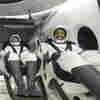
SpaceX mission returns from space station with ex-NASA astronaut, 3 paying customers
So the objectives of the crew weren't all that much different necessarily than a NASA mission, which is outreach and scientific investigations, but these were with the specific goals of expanding outreach in specific areas for Saudi – which hadn't had a person in space for 40 years – and, you know, to inspire their youth as well as inspiring the youth in the United States.
Space tourism took a giant leap in 2021: Here's 10 milestones from the year
From suborbital space to high Earth orbit, space tourism is just getting started.
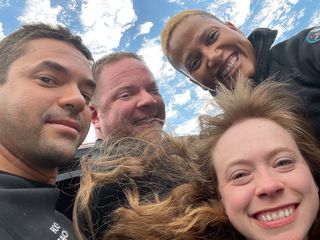
This year saw more space tourists fly to space on a bunch of different systems, and the story has only just begun.
Virgin Galactic , Blue Origin and SpaceX each flew their first tourist-focused missions this year, sending aloft several people each with minimal training in professional spaceflight. Meanwhile, Roscosmos (the Russian federal space agency) brought two sets of space tourists into space, including a mission with Space Adventures.
With 2022 also set to be busy, between more tourist flights and the expected addition of company Axiom Space (using a SpaceX Crew Dragon), we rounded up some of the main milestones of 2021 below.
Video: Life on the International Space Station in 2021
1) Axiom Space announces first crew for 2022

Axiom Space revealed its clients Jan. 26 for its first privately-funded and operated mission to the International Space Station (ISS). Called Axiom Mission 1 (Ax-1), the flight is arranged under a commercial agreement with NASA.
Slated to launch on a SpaceX Dragon spacecraft are Larry Connor, an American real estate and technology entrepreneur; Eytan Stibbe, a businessman and former Israeli fighter pilot; Mark Pathy, a Canadian investor and philanthropist; and Michael Lopez-Alegria, a retired NASA astronaut with nearly 260 days in space already across four missions.
In June, SpaceX and Axiom announced an agreement to fly three more missions to the orbiting complex after Ax-1. NASA officially cleared the Ax-1 crew for flight on Dec. 20.
Get the Space.com Newsletter
Breaking space news, the latest updates on rocket launches, skywatching events and more!
2) Starship launches test flight and sticks the landing
After several attempts on previous test landing that didn't make it safely to landing, SpaceX's Starship SN-15 prototype launched its own test flight May 5 and made it all the way from takeoff to touchdown.
The uncrewed test flight coincidentally fell on the 60th anniversary of the United States' first-ever crewed spaceflight, which saw NASA astronaut Alan Shepard make it to suborbital space. SpaceX has said it hopes to use Starship to branch out in the solar system, especially for crewed Mars missions.
3) Virgin Galactic launches Richard Branson

On July 11, Virgin Galactic launched its first operational tourist flight , featuring founder Richard Branson . It was "the experience of a lifetime," Branson said during a live broadcast of the flight.
The four-person crew and two pilots of the Unity 22 test flight mission took off from the company's Spaceport America facility in New Mexico and flew just above the boundary of space, where everyone experienced about four minutes of weightlessness.
Future flights of Virgin Galactic, though, have been delayed due to a Federal Aviation Administration investigation into a reported incident that happened during the spaceflight. That said, Virgin has opened up tickets again to paying spaceflyers, now at $450,000 apiece .
4) Blue Origin launches Jeff Bezos to space
Days after the Virgin flight, Blue Origin launched its first crewed spaceflight on July 20, featuring founder Jeff Bezos and a set of other three space tourists, including Mercury 13 aviator Wally Funk .
Since the system flies autonomously, no pilots were required to be on board (although Funk is highly qualified as an aviator) as the New Shepard system lifted off from Blue Origin's Launch Site One near the West Texas town of Van Horn.
While Bezos and Branson denied their companies were in competition , the broadcast of Bezos' flight made several cutting remarks about the company flying above the Kármán line , an internationally recognized boundary of spaceflight that Virgin Galactic flights don't reach.
Bezos also said in an interview in July that Blue Origin is not focused on competition, but building a "road to space." The company has adopted that catchphrase as a tagline and repeats it frequently during live broadcasts.
5) SpaceX stacks tallest booster ever with Starship
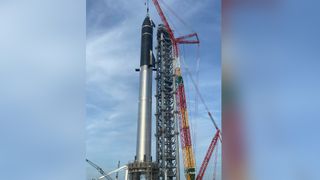
SpaceX's newest Starship prototype (SN-20) perched on its massive Super Heavy booster for the first time on Friday (Aug. 6), briefly setting a new record for the world's tallest rocket during preparations for an orbital mission.
The hour-long fit check brought the stack to 395 feet tall (120 m), taller than NASA's massive Saturn V moon rocket, which was 363 feet tall (110 m). Super Heavy alone stands 230 feet (70 meters) tall and Starship SN4 includes another 165 feet (50 m) of height.
The next major milestone for Starship is the orbital launch that may take place in 2022, pending an environmental review by the Federal Aviation Administration and related government groups. SpaceX founder Elon Musk has pushed back launch estimates several times due to the review.
6) Inspiration4 launches 4 civilians on first orbital mission
Billionaire Jared Isaacman's privately chartered spaceflight launched on Sept. 15, 2021 aboard a SpaceX Crew Dragon spacecraft, flying high in Earth orbit on a nearly three-day mission. Inspiration4 was the first crewed orbital mission with no professional astronauts on board (as the Virgin Galactic and Blue Origin flights preceding it were all suborbital missions.)
Isaacman, a pilot, commanded the flight and was accompanied by physician assistant Hayley Arceneaux, data engineer Chris Sembroski, and geoscientist and science communication specialist Sian Proctor. Sembroski and Proctor won their seats in contests to support St. Jude Children's Research Hospital in Memphis, while Arceneaux is employed at that hospital.
Resilience and its crew circled Earth for three days, splashing down off the Florida coast on Sept. 18 . The mission exceeded its fundraising goal for St. Jude.
7) Blue Origin launches William Shatner
A "Star Trek" star boldly went into suborbital space Oct. 13 on Blue Origin's second crewed space mission, called NS-18. William Shatner, 90, is best known for playing Captain James T. Kirk on "Star Trek: The Original Series."
"That was unlike anything they described," Shatner was heard saying via a radio link as the capsule parachuted back to Earth, after carrying him and three other crew members to suborbital space.
Shatner is now the oldest person to have ever flown to space, beating the record set by Wally Funk , 82, who flew on Blue Origin's first crewed flight July 20. Crew member Glen de Vries died in a plane crash weeks after the flight and Blue Origin dedicated their next crewed mission in December to him.
8) Russian film crew shoots drama on ISS
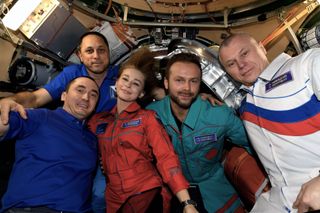
Just days after Shatner's ride to space, a Russian film crew including actress Yulia Peresild and producer Klim Shipenko landed with cosmonaut Oleg Novitskiy of the Russian federal space corporation Roscosmos on Oct. 17 .
"Вызов" ("Challenge" in English) is the movie in production. It follows the fictional story of a surgeon (Peresild) who is launched to the station to perform emergency surgery on a cosmonaut (Novitskiy, who would play the role well given he is a cosmonaut in real life.)
The effort is a joint production of Roscosmos , the Russian television station Channel One and the studio Yellow, Black and White. Given the small crew on hand in space, Shipenko took on several behind-the-scenes roles, including director, make-up artist, sound editor and cinematographer.
9) Blue Origin launches 'Good Morning America' host to space
Blue Origin's next (and likely last) crewed flight of 2021 filled out all six seats in the New Shepard spacecraft during a successful launch and landing Dec. 11 . The starring guest was Michael Strahan, host of "Good Morning America", who is a retired football player. (The crew threw mini-footballs in space to celebrate his past career.)
Strahan said the experience was amazing. "I want to go back," he told Blue Origin founder Jeff Bezos after returning to Earth. "Touchdown has a new meaning now!!!" he wrote on Twitter after the flight.
Also on the flight was Laura Shepard Churchley, 74, the daughter of NASA astronaut Shepard after whom the New Shepard system is named, and four other individuals who paid for their seats. Blue Origin has not yet released per-seat pricing for customers, and we are also awaiting details on their next planned crew launch.
10) Japanese billionaire Yusaku Maezawa flies to ISS
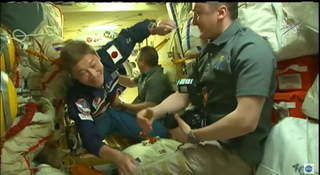
A Russian Soyuz spacecraft carrying Japanese billionaire Yusaku Maezawa, video producer Yozo Hirano and cosmonaut Alexander Misurkin launched on Dec. 8 to the International Space Station for a 12-day mission to the orbiting lab.
Maezawa is also planning to fly around the moon on a SpaceX mission that he paid for, tentatively slotted for 2023 , but chose to visit the space station as well on a mission brokered by the U.S. space tourism company Space Adventures with Russia's Roscosmos space agency. It was not revealed how much Maezawa paid for the flight, but single seats in the past have cost up to $35 million. And Maezawa bought two seats, one for himself and for Hirano, who recorded videos of Maezawa in space .
Maezawa, the CEO of Start Today and the founder of online clothing retailer ZOZO, bought the seats for himself and Hirano. Hirano documented the mission and participate in some health and performance research . They also made the first Uber Eats delivery in space on the flight. The trio returned to Earth on Dec. 19 .
And that's a wrap at the biggest space tourism moments in 2021. The year 2022 is expected to bring more milestones as the company Axiom Space plans to launch its first fully private crew to the International Space Station early in the year, with SpaceX, Blue Origin and Virgin Galactic all expected to continue their private spaceflight pace.
Follow Elizabeth Howell on Twitter @howellspace . Follow us on Twitter @Spacedotcom or on Facebook .
Join our Space Forums to keep talking space on the latest missions, night sky and more! And if you have a news tip, correction or comment, let us know at: [email protected].
Elizabeth Howell (she/her), Ph.D., is a staff writer in the spaceflight channel since 2022 covering diversity, education and gaming as well. She was contributing writer for Space.com for 10 years before joining full-time. Elizabeth's reporting includes multiple exclusives with the White House and Office of the Vice-President of the United States, an exclusive conversation with aspiring space tourist (and NSYNC bassist) Lance Bass, speaking several times with the International Space Station, witnessing five human spaceflight launches on two continents, flying parabolic, working inside a spacesuit, and participating in a simulated Mars mission. Her latest book, " Why Am I Taller ?", is co-written with astronaut Dave Williams. Elizabeth holds a Ph.D. and M.Sc. in Space Studies from the University of North Dakota, a Bachelor of Journalism from Canada's Carleton University and a Bachelor of History from Canada's Athabasca University. Elizabeth is also a post-secondary instructor in communications and science at several institutions since 2015; her experience includes developing and teaching an astronomy course at Canada's Algonquin College (with Indigenous content as well) to more than 1,000 students since 2020. Elizabeth first got interested in space after watching the movie Apollo 13 in 1996, and still wants to be an astronaut someday. Mastodon: https://qoto.org/@howellspace
SpaceX's Falcon 9 rocket can return to flight, FAA says
'Deadpool & Wolverine' has a sneaky Canadarm robot arm cameo at the end of time — but blink and you'll miss it
Best Alien comic books of all time
Most Popular
- 2 Weird mystery waves that baffle scientists may be 'everywhere' inside Earth's mantle
- 3 Astrophotographer captures Comet 13P/Olbers and the Black Eye Galaxy M64 in stunning detail (photo)
- 4 SpaceX launches back-to-back Falcon 9 rockets within 65 minutes and aces 2 landings days after a failed booster touchdown (video)
- 5 Rocket Lab's Mars probes reach launch site ahead of 1st flight on Blue Origin New Glenn rocket (photos)
We combed through thousands of Labor Day deals — these are the absolute best
- Share this —

- Watch Full Episodes
- Read With Jenna
- Inspirational
- Relationships
- TODAY Table
- Newsletters
- Start TODAY
- Shop TODAY Awards
- Citi Concert Series
- Listen All Day
Follow today
More Brands
- On The Show
- TODAY Plaza
William Shatner says he's 'so filled with emotion' after reaching edge of space
More than 50 years after he debuted as the beloved Capt. James T. Kirk in the original series of "Star Trek," William Shatner boldly flew to the edge of space.
The 90-year-old actor launched Wednesday aboard a rocket and capsule developed by Blue Origin, the private spaceflight company founded by Amazon founder Jeff Bezos. The historic joyride made Shatner the oldest person to reach space .
"It was unbelievable," Shatner said shortly after emerging from the capsule. "I'm so filled with emotion."
Shatner and three other crew members — Audrey Powers, Blue Origin’s vice president of mission and flight operations, and two paying customers, Glen de Vries and Chris Boshuizen — rode Blue Origin's New Shepard rocket and capsule to the edge of space. Liftoff occurred at around 10:50 a.m. ET and the entire flight lasted roughly 10 minutes.
Bezos escorted the four passengers to the launch pad and greeted them after their spacecraft touched down again. After Shatner climbed out of the capsule, he hugged Bezos and shared how moved he was by the brief trip.
"What you have given me is the most profound experience I can imagine," he told Bezos through tears. "I am overwhelmed. I had no idea."
Shatner recalled feeling jittery before liftoff, and spoke about what it was like to accelerate to the edge of space. He also described seeing the planet's thin atmosphere and gazing back at the curvature of Earth.
"There's this soft blue," Shatner said. "And it’s so thin. And you’re through it in an instant."
I do not know what I may appear to the world, but to myself I seem to have been only like a boy playing on the seashore, diverting myself in now & then finding a smoother pebble or a prettier shell than ordinary, whilst the great ocean of truth lay all undiscovered before me.🚀 pic.twitter.com/ZY2Ka8ij7z — William Shatner (@WilliamShatner) October 13, 2021
During the flight, the "Star Trek" actor tweeted a quote from the 17th-century physicist Isaac Newton: "I do not know what I may appear to the world, but to myself I seem to have been only like a boy playing on the seashore, diverting myself in now & then finding a smoother pebble or a prettier shell than ordinary, whilst the great ocean of truth lay all undiscovered before me."
The mission was delayed by nearly an hour as crews at the launch pad worked to ensure that the rocket was ready for flight. Previously, high winds at the Texas launch site also forced Blue Origin to push the expedition from its originally scheduled time earlier in the week.
In an interview last week with TODAY , Shatner spoke about his anticipation for the upcoming flight.
“I’m going to see the vastness of space and the extraordinary miracle of our Earth and how fragile it is compared to the forces at work in the universe — that’s really what I’m looking for," he said.
Shatner's trip was Blue Origin's second launch of an all-civilian crew. The company's inaugural flight in July was a high-profile and high-stakes event, with Bezos, his brother and two other passengers onboard.
The New Shepard rocket and capsule are designed for suborbital jaunts, which don't actually enter into orbit around Earth but rather fly to the edge of space, at an altitude of more than 65 miles, where passengers can experience around four minutes of weightlessness.
Wednesday's flight launched from a site in west Texas, southeast of El Paso. After liftoff, the rocket accelerated toward space at three times the speed of sound. At an altitude of approximately 250,000 feet, the New Shepard capsule separated, taking Shatner and his crew members to the edge of space.
After reaching a peak altitude of 351,000 feet, the craft then descended under parachutes and landed again in the Texas desert.
Shatner's expedition was the latest in what has been a recent flurry of space tourism flights. Nine days before Bezos flew to the edge of space, British billionaire Richard Branson completed his own suborbital joyride , riding aboard a rocket-powered vehicle developed by his own space tourism company, Virgin Galactic.
Neither Blue Origin nor Virgin Galactic have announced final pricing for their suborbital flights, but tickets are expected to cost several hundreds of thousands of dollars.
And in addition to trips to the edge of space, people with deep pockets may soon be able to pay for orbital experiences and more prolonged stays in microgravity.
Last month, SpaceX, the spaceflight company founded by billionaire Elon Musk, launched four private passengers into orbit around Earth on a three-day expedition. That flight made history as the first orbital launch with an all-civilian crew .
SpaceX is also preparing to launch three private passengers, who each paid $55 million, to the International Space Station in early 2022.
This article was originally published on NBCNews.com .
More Trending

Who is Brad Pitt's girlfriend, Ines de Ramon?

42 Labor Day food deals to fuel your celebration
Restaurants.

Para archer Jodie Grinham becomes 1st athlete to win Paralympics medal while pregnant

Woman taught her pet pig to communicate — now his tantrums are next-level in viral video
Pets & animals.

Black man expresses ‘disgust’ over receiving Chick-fil-A receipt with ‘Monkeys’ as his name

Capri Sun responds to rumors that it’s getting rid of its iconic pouches

Craig Melvin reflects on the friendship at TODAY that got him through his ‘darkest moments’
Pop culture.

‘Yellowstone’ Season 5, Part 2 has a release date. Is Kevin Costner in it? What to know

Are you ready, kids? Wendy’s is reportedly releasing a ‘SpongeBob’ Krabby Patty burger

A look at ‘DWTS’ pro Artem Chigvintsev and former WWE star Nikki Garcia’s relationship timeline
- Share full article
Advertisement
Supported by
For His Second Trip to Space, Billionaire Has Grander, Riskier Aspirations
Jared Isaacman is leading three other privately trained astronauts on a SpaceX vehicle for Polaris Dawn, a mission that will include a daring spacewalk.

By Kenneth Chang
Kenneth Chang has been reporting on Jared Isaacman’s spaceflight efforts since early 2021 .
Aug. 27: This article was updated to reflect postponements of the launch.
Three years ago, a billionaire entrepreneur named Jared Isaacman made a groundbreaking trip to space. That spaceflight, which Mr. Isaacman called Inspiration4 , was the first to orbit the Earth without a professional astronaut aboard.
In the coming days, Mr. Isaacman, the founder and chief executive of Shift4, a payment processing company, is planning to head into space again. This time the itinerary is longer, more daring and riskier, and includes a spacewalk, the first by private astronauts.
The mission, named Polaris Dawn, hearkens back to the earliest era of spaceflight, the 1960s, when pioneers like Yuri Gagarin of the Soviet Union and John Glenn of NASA pushed the boundaries of what had been accomplished in space, learning how to survive and operate in an airless and weightless environment.
But unlike those expeditions, undertaken by national space agencies, this is a purely commercial effort. For Polaris Dawn, Mr. Isaacman is collaborating closely with Elon Musk and his rocket company, SpaceX, to start laying the foundations for Mr. Musk’s dream of someday sending people to Mars .
“There’s always a risk calculus to it,” Mr. Isaacman said in an interview a week and a half ago, before he and his three crewmates headed to Florida for the launch. “But the real focus is on what we stand to gain and learn from it. And in this case, we’ve got some pretty cool things.”
Most astronaut missions these days are almost boringly routine, basically taxi rides ferrying people to and from an orbiting space station.
The Polaris Dawn mission is not going to a space station. Instead, it is going farther than anyone has traveled since the Apollo 17 mission went to the moon in 1972.
“It’s time to explore,” William Gerstenmaier, a former NASA official who is now the vice president for build and flight reliability at SpaceX, said during a news conference on Aug. 19.
A SpaceX Falcon 9 rocket will launch a Crew Dragon capsule — the same spacecraft that takes NASA astronauts to the International Space Station, or I.S.S. — into an elliptical orbit that swings much farther away from Earth. The Polaris Dawn astronauts will pass through regions of intense radiation, and risk bombardment from tiny space rocks as well as bits of human-made debris that could puncture the spacecraft.
The upside of the journey is that it will test new technologies and gather data on the effects it has on the human body when people venture deeper into space.
“This is a mission that sets out to accomplish a lot of things in a very short period,” Mr. Isaacman said. “We have some pretty ambitious objectives.”
For this flight, SpaceX developed a new spacesuit to be used for the spacewalk, and will also try sending communications via laser pulses, instead of radio signals, between the Crew Dragon and SpaceX’s Starlink constellation of internet satellites .
On Tuesday evening, concerns about weather in areas where the returning spacecraft would splash down prompted SpaceX to cancel launch attempts on Wednesday and Thursday. The company said it would announce a future launch attempt when possible. That announcement followed an earlier delay so SpaceX could investigate a helium leak in the umbilical line that provides helium to the rocket.
While Mr. Isaacman led and financed Inspiration4 — he essentially chartered a flight using a Falcon 9 rocket and a Crew Dragon capsule from SpaceX — Polaris Dawn and two subsequent missions are, in Mr. Isaacman’s words, a “joint effort” between Mr. Isaacman and SpaceX.
Mr. Isaacman declined to say how much he or SpaceX has spent. “We don’t ever get into the costs on all this,” he said. “I would just say that there is obviously a lot of contributions that are coming from SpaceX, and myself, in this.”
Two members of the Polaris Dawn crew are SpaceX employees: Anna Menon, a lead space operations engineer, and Sarah Gillis , who oversees astronaut training.
The other two crew members are Mr. Isaacman and Scott Poteet, a retired U.S. Air Force Pilot and longtime friend of Mr. Isaacman’s who served as the mission director on the ground during Inspiration4.
Polaris Dawn will travel farther from the planet than anyone since the Apollo moon landings ended more than 50 years ago. The first few orbits will pass through a dent in the Earth’s magnetic field known as the South Atlantic Anomaly; this magnetic weak spot allows high-energy charged particles from regions known as the Van Allen belts to come much closer to Earth’s surface.
Within a few hours, the Polaris Dawn crew will receive a dose of radiation equivalent to what astronauts on the I.S.S. absorb in three months.
After the Crew Dragon completes about eight orbits, the spacecraft’s thrusters will fire to push the apogee, or farthest point of the orbit, to 870 miles above the planet.
That will be about 17 miles higher than the 853-mile altitude NASA astronauts Pete Conrad and Richard Gordon reached during the Gemini XI mission in 1966, still the record for astronauts on a spaceflight that did not head to the moon.
After about six of these high orbits, the Crew Dragon will fire its thrusters again to drop the spacecraft down to a lower, elliptical orbit, with an apogee of 435 miles.
The highlight of the five-day journey is scheduled for the third day: the spacewalk. During the two-hour operation, the astronauts will put on their spacesuits before all the air is let out of the Crew Dragon; the inside of the spacecraft will become part of the vacuum of outer space.
Then two crew members — Mr. Isaacman and Ms. Gillis, connected by umbilical cords that will provide power, air and other life support needs — will move outside the spacecraft to conduct tests on the spacesuits.
Mr. Poteet and Ms. Menon will remain inside the capsule, keeping an eye on the displays and managing the umbilical cords, but “taking all the same risks we are in the vacuum of space,” Mr. Isaacman said.
When Mr. Isaacman first announced a series of three space missions in February 2022, he said Polaris Dawn would take place by the end of that year. But the date slipped repeatedly as SpaceX engineers studied how to make the flight as safe as possible.
“At this point, there is no stone that they haven’t turned to make sure that we’re thinking about absolutely everything we can,” Ms. Gillis said.
The new technologies needed for Polaris Dawn also went through numerous iterations and tests.
Mr. Isaacman recalled that he and Ms. Gillis had gone to NASA’s test facility at White Sands, N.M., to observe small projectiles fired at the spacesuits to see how they would stand up. “We obviously weren’t in them," he said, “but to see how the suit performs in a micrometeorite environment.”
To help ensure that the spacewalk will go smoothly, the entire Crew Dragon capsule was placed in a large vacuum chamber, simulating the emptying of air that will be performed before the spacewalk, and then refilling the capsule with oxygen and nitrogen after the hatch was closed again.
The crew members acknowledge that risks remain, but said that they and the 14,000 employees at SpaceX had done everything they could to be ready to handle them.
“The first time we got into the simulator and we had to work as a crew, it went horribly wrong,” Ms. Gillis said. “We had so much to learn because we weren’t able to yet work as a team.”
She added, “One of my most favorite parts of this journey is actually figuring out how we bring together these incredible skill sets to build a team that can go execute on these objectives and be successful as a team.”
The crew will conduct about 40 experiments, including obtaining magnetic resonance images of the astronauts’ brains and attempting to take X-ray images without an X-ray machine by using the natural showers of radiation that stream through outer space.
“We’re going to spend every waking moment on orbit addressing these issues so we can capitalize on this opportunity,” Mr. Poteet said.
Mr. Poteet even underwent surgery to implant a device that was to measure the pressure of fluid around his brain. As astronauts float in orbit, fluids within their bodies shift upward, which may increase pressure inside their skulls, a potential cause of the squashed eyeballs , swollen optic nerves and blurred vision some astronauts have experienced.
However, the device was removed. “It was an experimental surgery,” Mr. Poteet said. “That particular device just didn’t work out.”
The five-day mission will end with a splashdown off the coast of Florida.
The crew will be thinking about their families during the voyage.
“I think often they have the hardest job while we’re on this endeavor,” Ms. Menon said. “One way that I have been connecting with my family on this journey is I wrote a children’s book named ‘Kisses from Space.’ ”
She and her co-author, Keri Vasek, wanted to tell “a story about the power of love to overcome any distance,” Ms. Menon said. “And it’s the story that I wrote for my kids on this journey, and I’ll have the chance to read it to them from space.”
Kenneth Chang, a science reporter at The Times, covers NASA and the solar system, and research closer to Earth. More about Kenneth Chang
What’s Up in Space and Astronomy
Keep track of things going on in our solar system and all around the universe..
Never miss an eclipse, a meteor shower, a rocket launch or any other 2024 event that’s out of this world with our space and astronomy calendar .
A speeding star is traveling through the Milky Way at around a million miles an hour. It could be moving fast enough to break free from the gravitational clutches of the galaxy .
In 1924, a radio receiver built for the battlefields of World War I tested the idea that humans were not alone in the solar system, heralding a century of searches for extraterrestrial life .
A study adds strong evidence to the hypothesis that the asteroid that killed the dinosaurs came from a family of objects that originally formed well beyond the orbit of the planet Jupiter.
Is Pluto a planet? And what is a planet, anyway? Test your knowledge here .

IMAGES
VIDEO
COMMENTS
Learn about the history of space tourism, the companies that offer orbital and suborbital flights, and the costs and environmental impacts of this industry. Find out if you can become a space tourist and what you can expect from such a trip.
Virgin Galactic is launching a new space age, where all are invited along for the ride.
American investment management billionaire Dennis Tito became the first to self-fund a trip in 2001 with his eight-day stay on the International Space Station, and six others came after him.
Experience weightlessness and view Earth from above the Kármán line with New Shepard, a fully reusable and carbon-free rocket. Learn how to train, tour, and book your spaceflight with Blue Origin.
Space Perspective offers the largest spaceflight capsule with Wi-Fi, culinary program, and panoramic views. Learn about the Spaceship Neptune, the Space Lounge, and the world-class team behind this new way to travel to space.
Compare different space tourism options from $125K to $60M, from suborbital rides to orbital voyages. Learn about the features, benefits, and challenges of each package, and how to book your seat in space.
International Space Travel Bureau, a collaboration agency with NASA, pioneers in designing unprecedented experiences beyond the earth's boundaries. We aim to make the cosmos more accessible, offering affordably priced, fully-customizable space travel packages that transport you to unimaginable destinations. Step into the future of tourism with ...
Learn how NASA develops and demonstrates technologies to explore the Moon, Mars, and beyond. Find out about launch and propulsion systems, cryogenic fluid management, thermal management, and more.
Learn what former NASA astronauts Chiao and Parazynski recommend for first-time spaceflight participants. Find out how to prepare for launch, reentry, weightlessness, and more.
CNN —. Virgin Galactic — the space tourism company founded by British billionaire Richard Branson — finally launched its first space tourists to the edge of the cosmos, a major step toward ...
Space Travel News. Stay up-to-date with the latest content from NASA as we explore the universe and discover more about our home planet. First NASA-Supported Researcher to Fly on Suborbital Rocket. 2 min read For the first time, a NASA-funded researcher will fly with their experiment on a commercial suborbital rocket. The technology is…
Learn how to join the virtual guest list for Artemis I, an uncrewed flight test that will pave the way for human exploration of the Moon. Find out what to see, what to bring, and how to get ready for your trip to the Moon with this ultimate personal tour guide.
These are the four people launching on SpaceX's first ISS space tourism mission. By Jackie Wattles, CNN Business. 8 minute read. Updated 8:17 PM EDT, Thu April 7, 2022. Link Copied! The AX-1 ...
The History of Space Tourism . Traveling to space has long been the domain of professional astronauts, not ordinary citizens. But that all changed when American entrepreneur Dennis Tito flew to space in 2001 with space tourism company Space Adventures, who organized the trip with Russian space agency Roscosmos.
Space Tourism Is Here: Booking a Trip to the Final Frontier. The next era of space exploration and innovation is here — and we're all invited. Space tourism is officially taking flight, and it ...
Photo courtesy of SpaceX. We've previously discussed whether SpaceX counts as a space tourism company, but as of late 2018 it's official: SpaceX has agreed to take Japanese entrepreneur and billionaire Yusaku Maezawa along with several artists on a trip around the moon. The target launch window is 2023; we'll see how that timeline is adjusted as we get closer to launch.
By Ben Guarino. January 9, 2023 at 6:00 a.m. EST. The space just above our planet is booming. Off-world trips are rapidly increasing: 42 of the 51 commercial astronauts recognized by the Federal ...
Everything you need to know about space travel (almost) - BBC Science Focus Magazine.
The pros of space tourism. A handful of private individuals, colloquially known as space tourists, managed to purchase tickets to the ISS or Russia's Mir station.
The trip featured the youngest and oldest people to travel to space. The New Shepard's flight included both the oldest and youngest people to travel to space. Funk, 82, is one of the last ...
Space tourism is human space travel for recreational purposes. [ 1] There are several different types of space tourism, including orbital, suborbital and lunar space tourism. Tourists are motivated by the possibility of viewing Earth from space, feeling weightlessness, experiencing extremely high speed and something unusual, and contributing to ...
By Denise Chow. SpaceX has made history. Again. The spaceflight company founded by the billionaire Elon Musk launched four private passengers into orbit Wednesday on the first mission to space ...
Axiom Space. 1. Space exploration will be a mix of public and private money. If you look at even the NASA missions returning to the moon, lots of different private space companies are involved in ...
5) SpaceX stacks tallest booster ever with Starship. SpaceX's first orbital Starship SN20 is stacked atop its massive Super Heavy Booster 4 for the first time on Aug. 6, 2021 at the company's ...
Jason Lyon. By Debra Kamin. May 7, 2022. Ilida Alvarez has dreamed of traveling to space since she was a child. But Ms. Alvarez, a legal-mediation firm owner, is afraid of flying, and she isn't ...
After liftoff, the rocket accelerated toward space at three times the speed of sound. At an altitude of approximately 250,000 feet, the New Shepard capsule separated, taking Shatner and his crew ...
Aug. 27: This article was updated to reflect postponements of the launch. Three years ago, a billionaire entrepreneur named Jared Isaacman made a groundbreaking trip to space. That spaceflight ...
Space exploration is the use of astronomy and space technology to explore outer space. [1] While the exploration of space is currently carried out mainly by astronomers with telescopes, its physical exploration is conducted both by uncrewed robotic space probes and human spaceflight.Space exploration, like its classical form astronomy, is one of the main sources for space science.